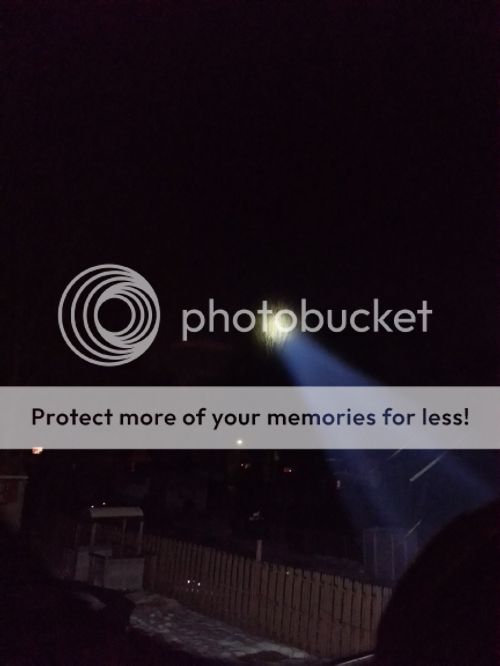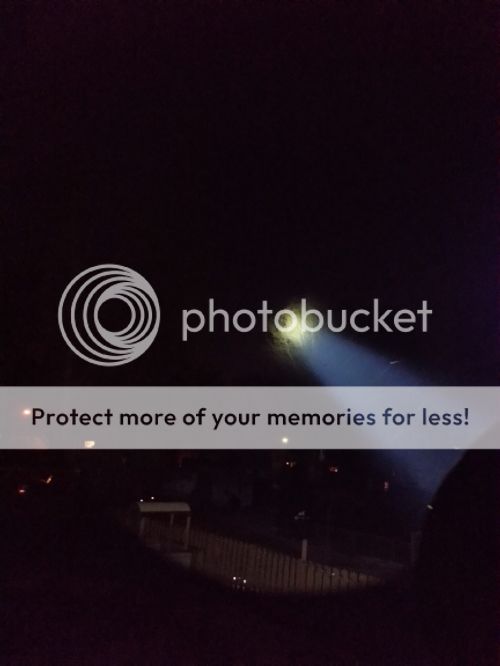Thrunite TN32 (XM-L2, 3x18650) "Thrower" Review: RUNTIMES, BEAMSHOTS, VIDEO+
Warning: even more pic heavy than usual.
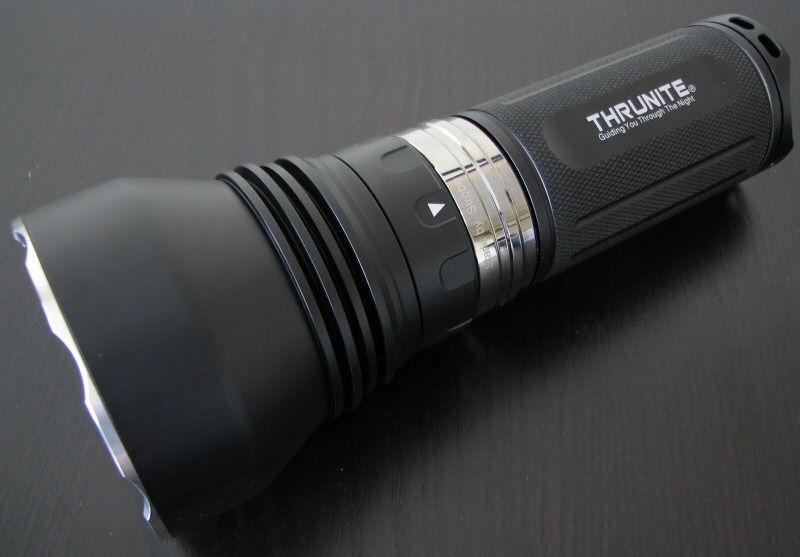
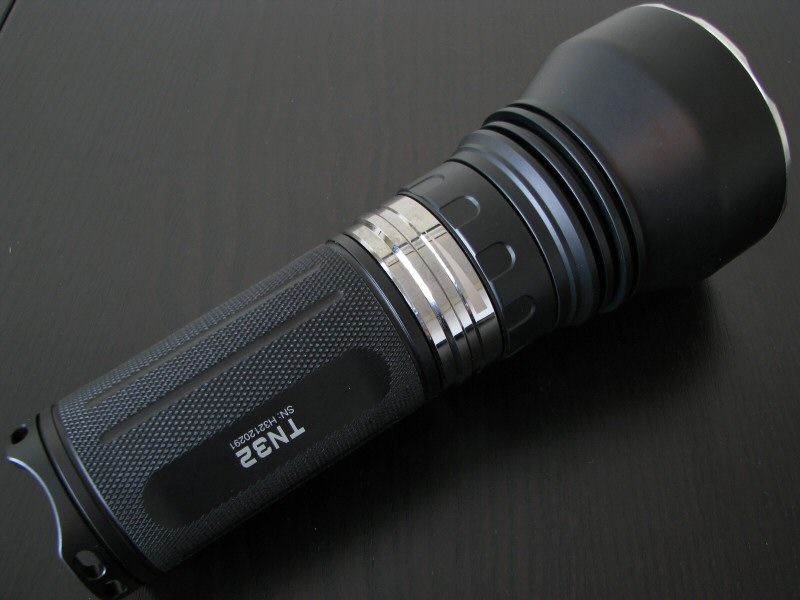
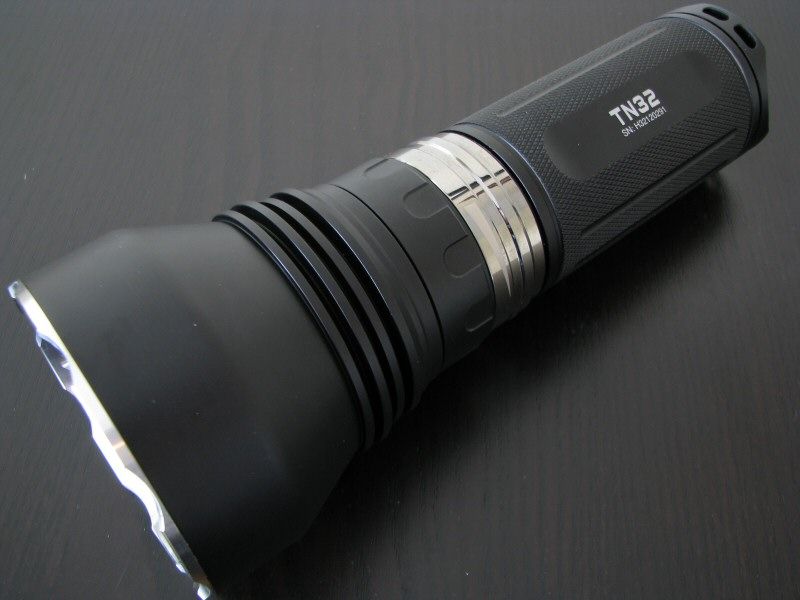
Thrunite has sent me their updated 1xXM-L2, 3x18650 "thrower" light, now known as the TN32. The likely reason for the new model number is the significant internal build differences from the old TN31 that I reviewed previously.
Let's see how it compares …
Manufacturer Reported Specifications:
(note: as always, these are simply what the manufacturer provides – scroll down to see my actual testing results).
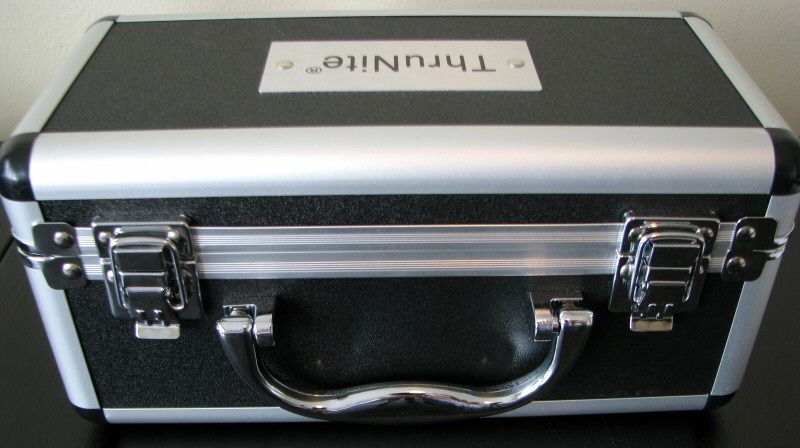
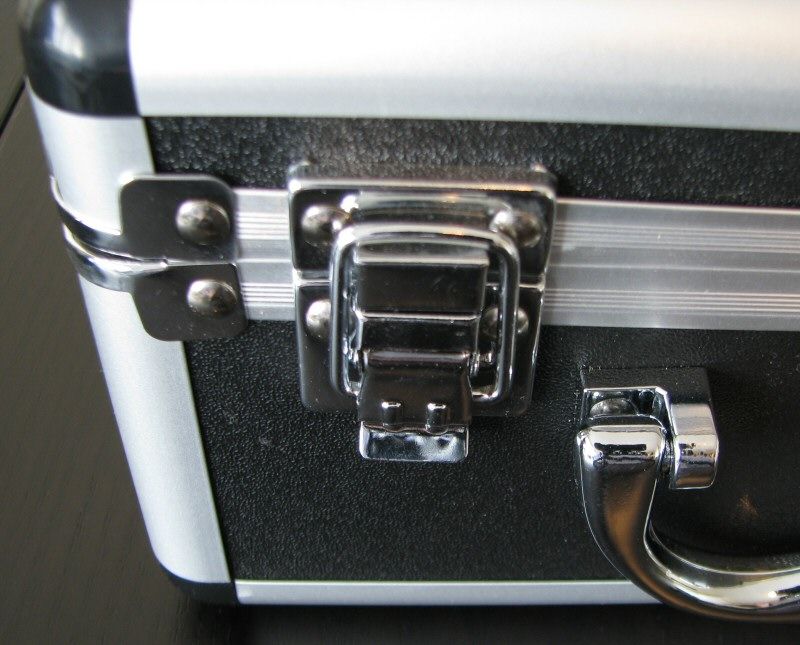
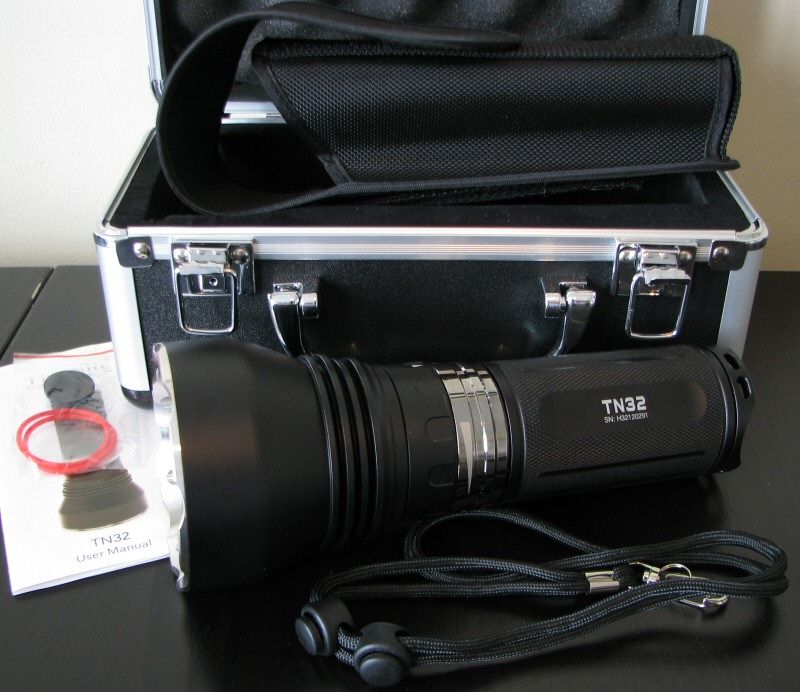
Packaging has been updated slightly, but is generally not that different. The TN32 still comes in a presentation case, with metal hinges and closing clasps. Inside are the light, belt pouch, wrist lanyard, manual, warranty card, and extra o-rings and spare boot cover.
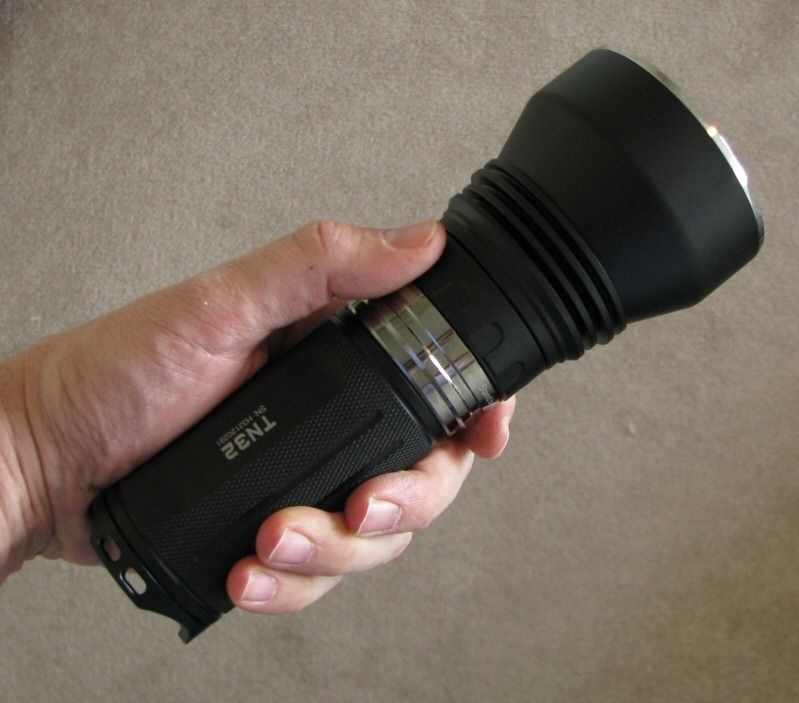
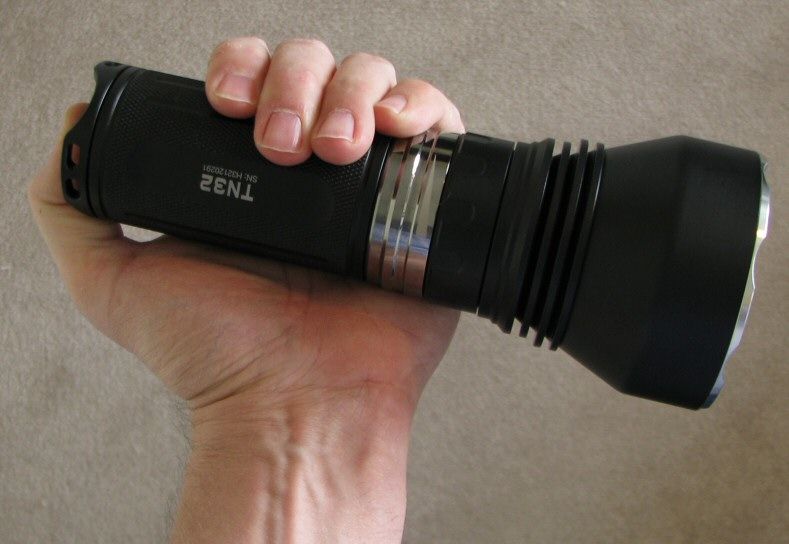
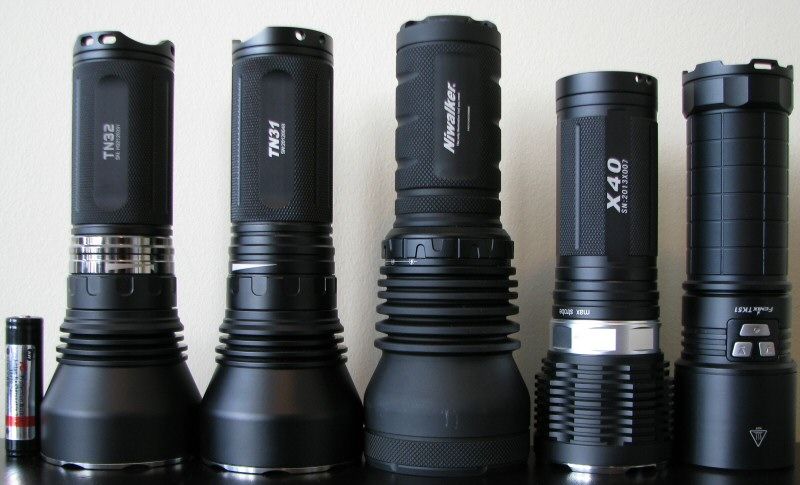
From left to right: AW Protected 18650 2200mAh; Thrunite TN32, TN31; Niwalker Vostro BK-FA01; L3 Illumination X40; Fenix TK51.
All dimensions directly measured, and given with no batteries installed (unless indicated):
Thrunite TN32 (XM-L2): Weight: 655.9g (808g with 3x18650), Length: 201mm, Width (bezel): 79.0mm
Thrunite TN31 (XM-L): Weight: 572g (est 724g with 3x18650), Length: 203mm, Width (bezel): 79.0mm
ArmyTek Barracuda (XM-L2): Weight 400.8g, Length 264mm, Width (bezel): 64.0mm
Eagletac MX25L2 Turbo (SBT-70):Weight: 698.6g (with battery pack: 974.1g), Length: 292mm, Width (bezel): 91.3mm
Niwalker BK-FA01 (XM-L2): Weight: 682.3g (864g with 4x18650), Length: 209mm, Width (bezel): 80.0mm, Width (tailcap): 50.3mm
Olight SR95S-UT (SBT-70): Weight: 1,208g (with battery pack), Length: 323mm, Width (bezel): 87mm
Olight SR95-UT (SBT-90): Weight: 1,221g (with battery pack), Length: 323mm, Width (bezel): 87mm
Skilhunt K30-GT (SBT-90): Weight: 635.9g (773g with 3x18650), Length: 199m, Width (bezel): 76.0mm
As you can see, weight has increased on the TN32, without appreciable changes in the dimensions (compared to the TN31).
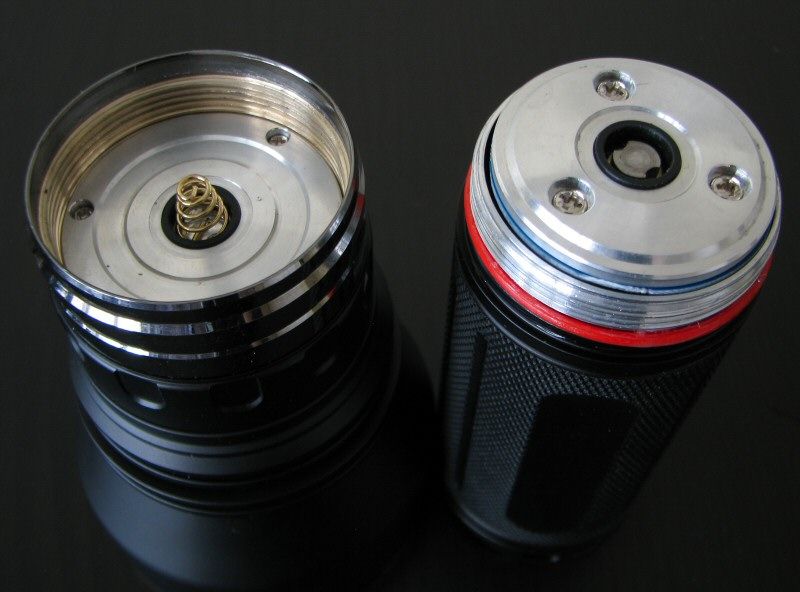
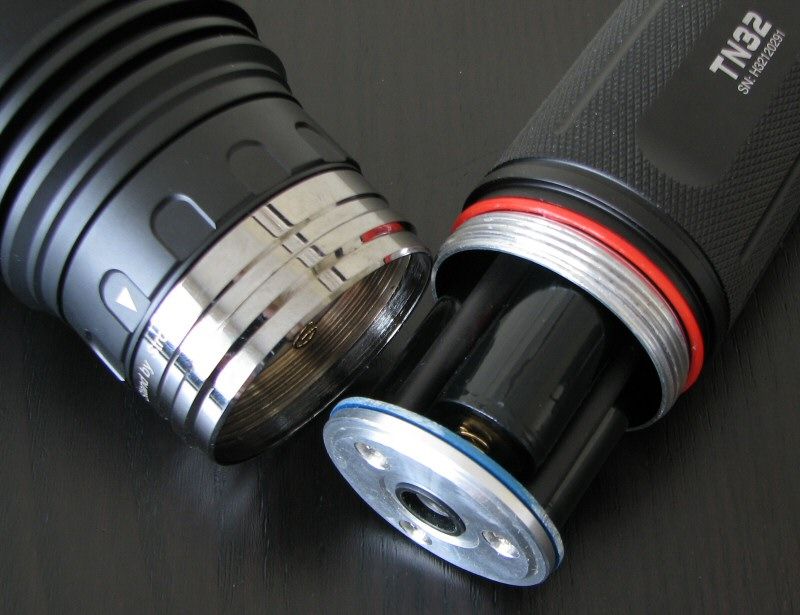
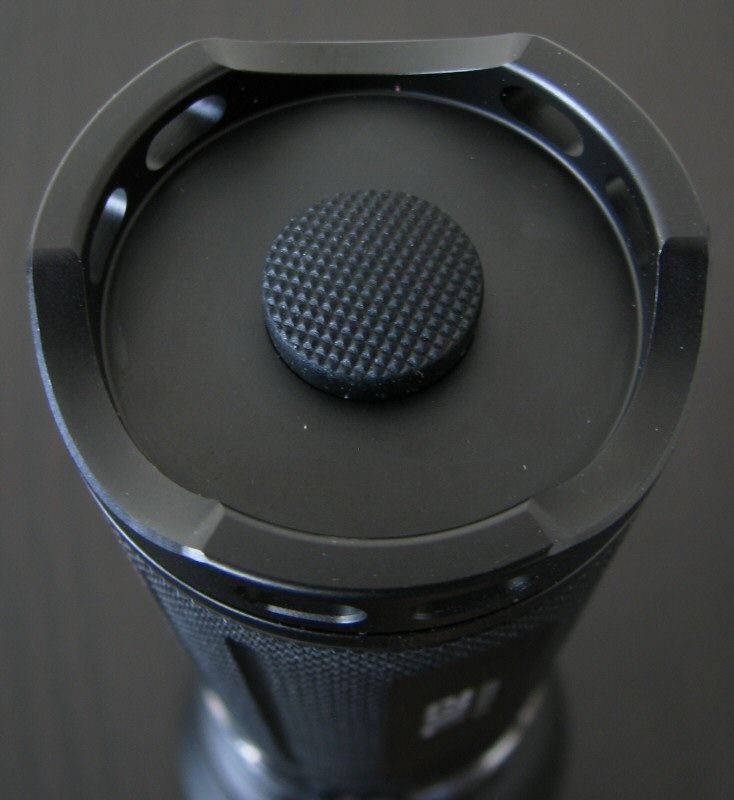
As before, overall anodizing is a glossy black. Quality seems very good as always, there were no chips or damage on my sample. Labels were sharp and bright white against the black background. Knurling is fairly aggressive on the handle, helping with grip.
One difference I noticed - screw threads are no longer anodized for head lock-out. I suspect this change has to do with the new brass heatsink module in the head (see discussion below). Threads are standard triangular cut, but seem of good quality.
The control ring feels much like before, with detents for the various defined modes (and cut-out indentations on the ring itself, to help with grip). The main external change to the light is the base of the head – rather than regular black anodized aluminum, there is now a smooth, shiny, chrome-plated brass heatsink. Labels for the control ring indicator arrow are now on this chrome-plated area, as shown below.
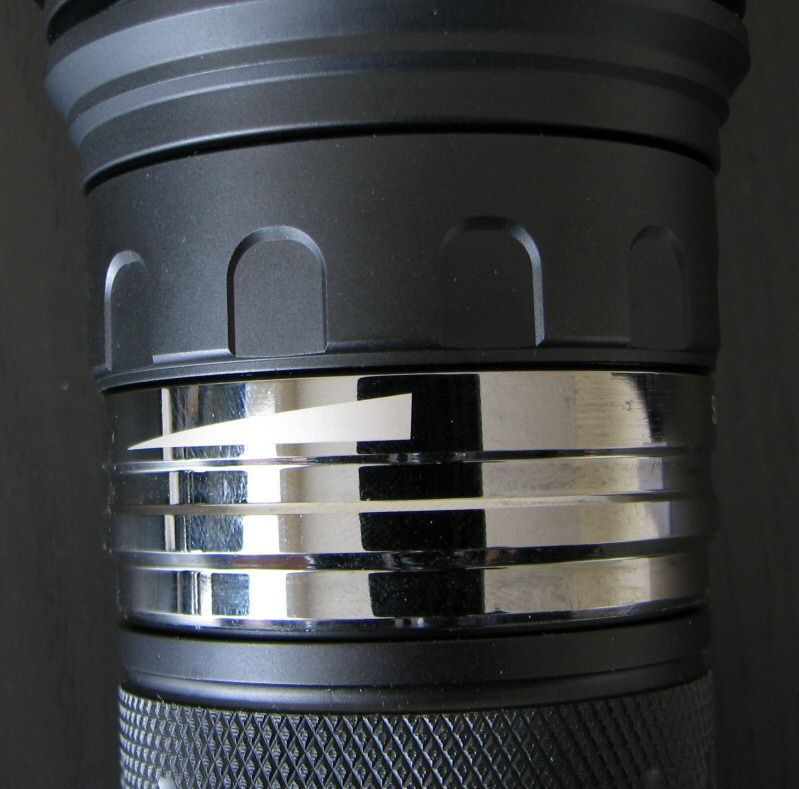
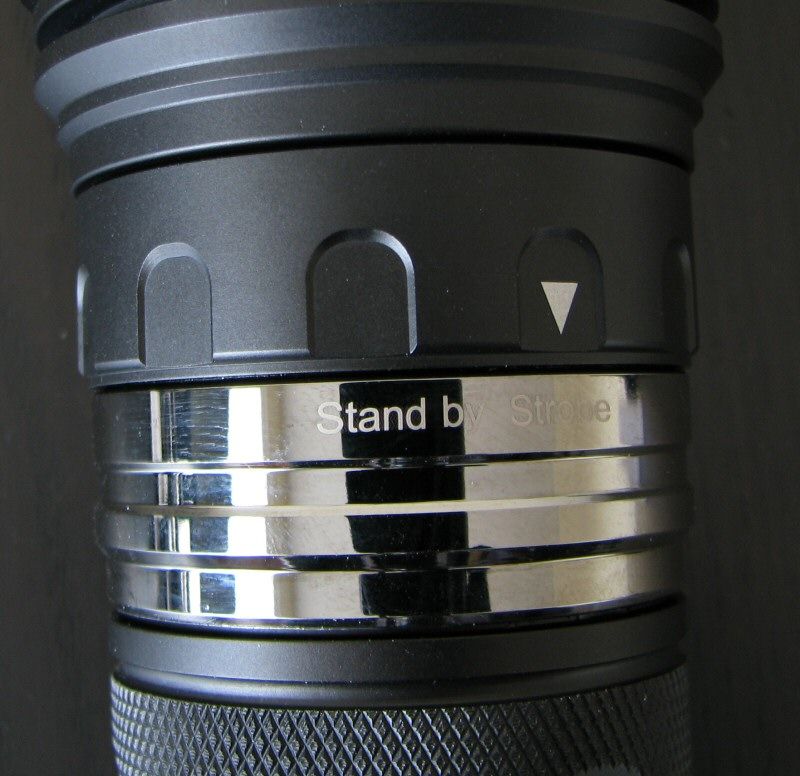
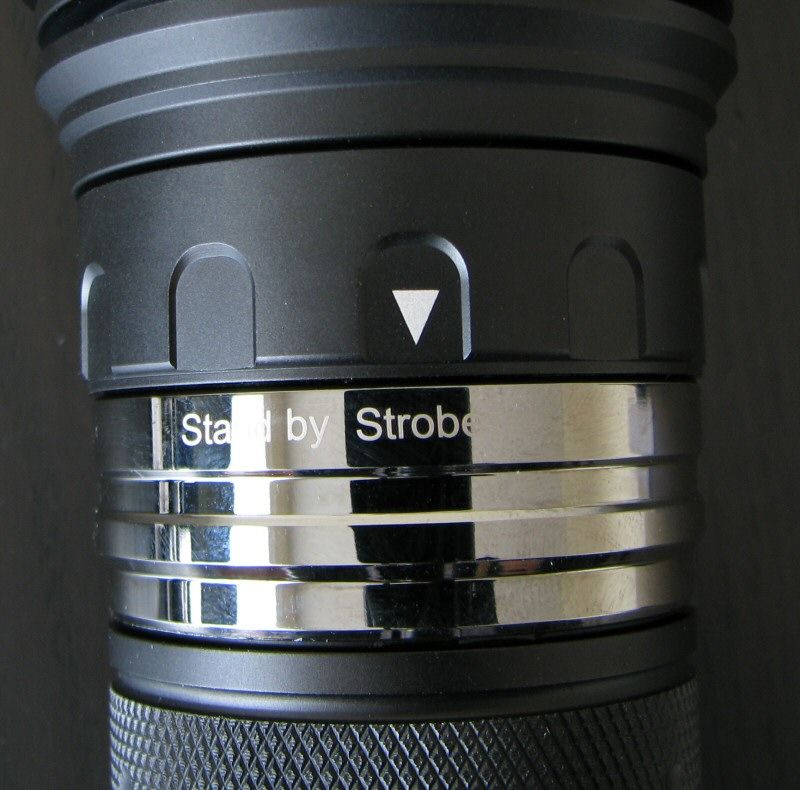
As before, the six constant output modes are not individually labeled, but there is a graded output bar pictogram over the first couple of levels (i.e., shows the direction to turn to raise or lower the output). Scroll down to my User Interface and Standby Drain sections for a discussion of how the light works.
While the chrome-plating provides a bit of bling, the real difference to the light is the brass underneath. Encasing the emitter and circuit housing, this should provide for much better thermal transfer (allowing for higher drive levels, and thus higher maximum output). It likely also explains the much greater weight of the TN32 over the TN31. Note that Thrunite also reports use of copper in the circuit design as well now (for improved heat transfer).
Note that Thrunite also reports use of copper in the circuit design as well now (for improved heat transfer).
As an aside, the TN31 was a very popular build for modders here, who could provide a custom light engine with improved heatsinking. The TN32 may thus be seen as an attempt to turn a mass-produced light into something of a "hot-rod" model by default. :devil:
Let's look at the carrier:
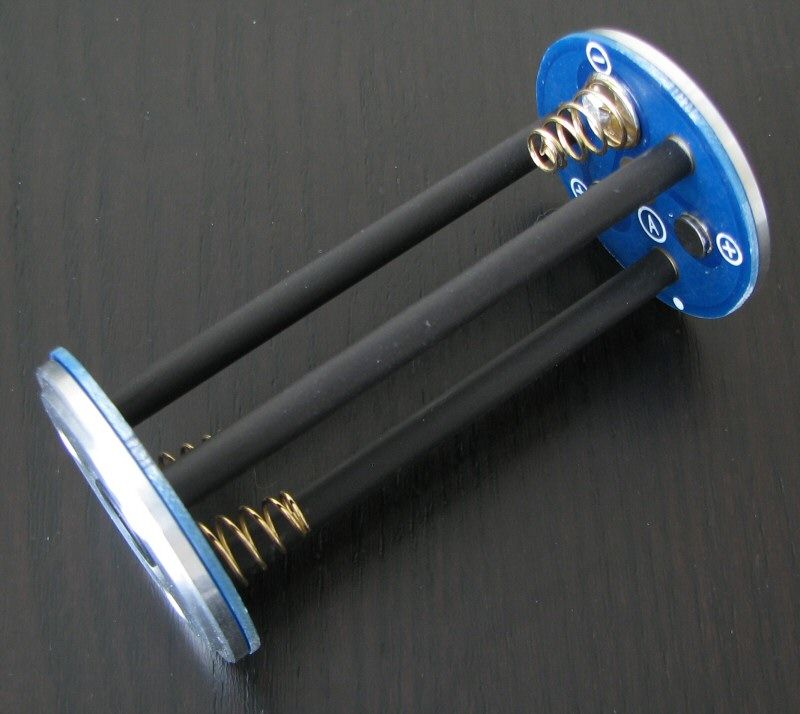
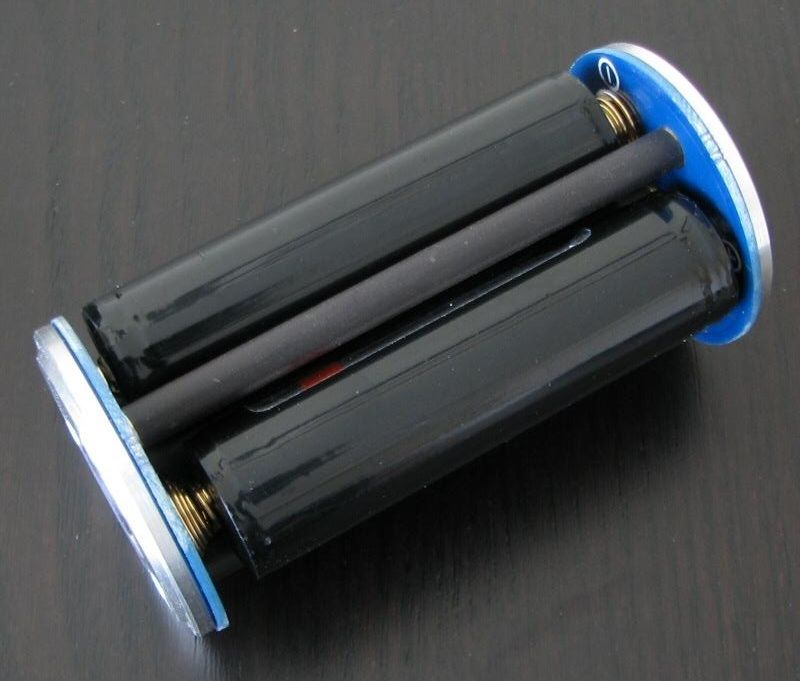
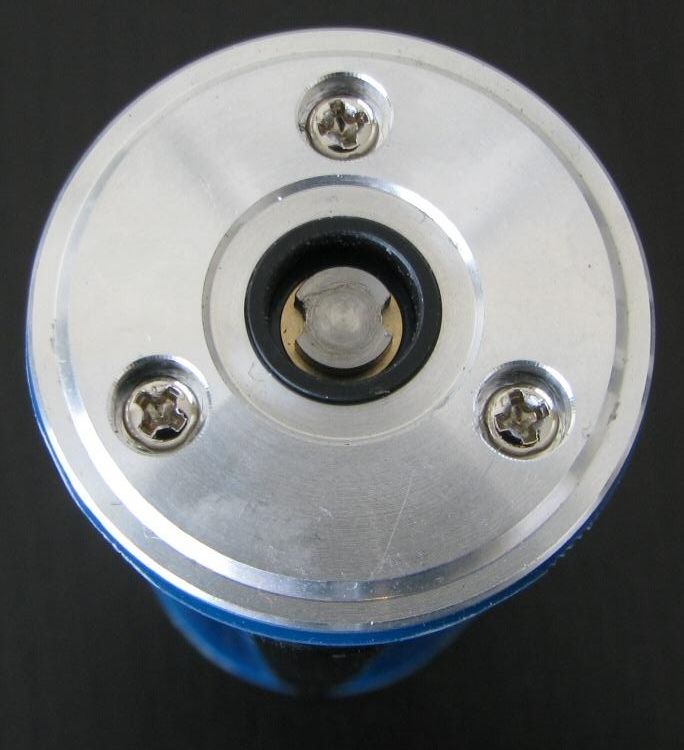
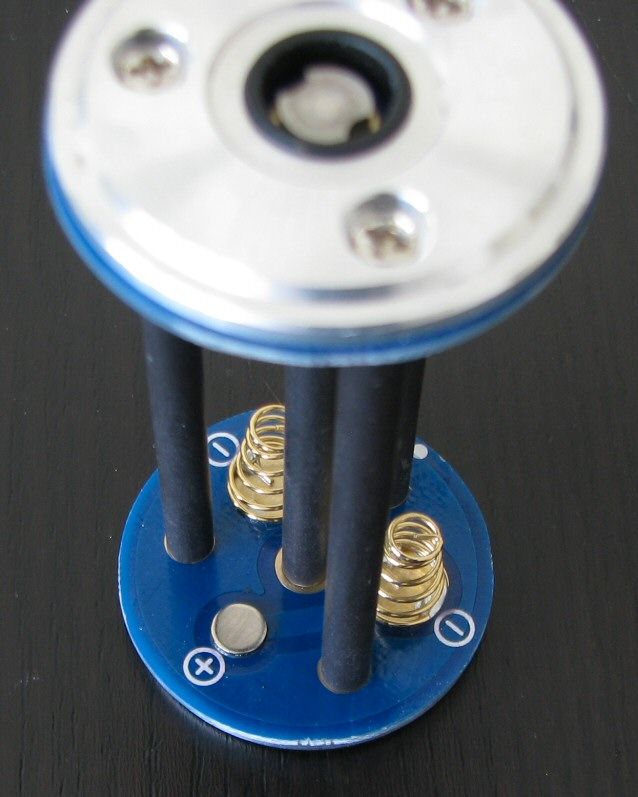
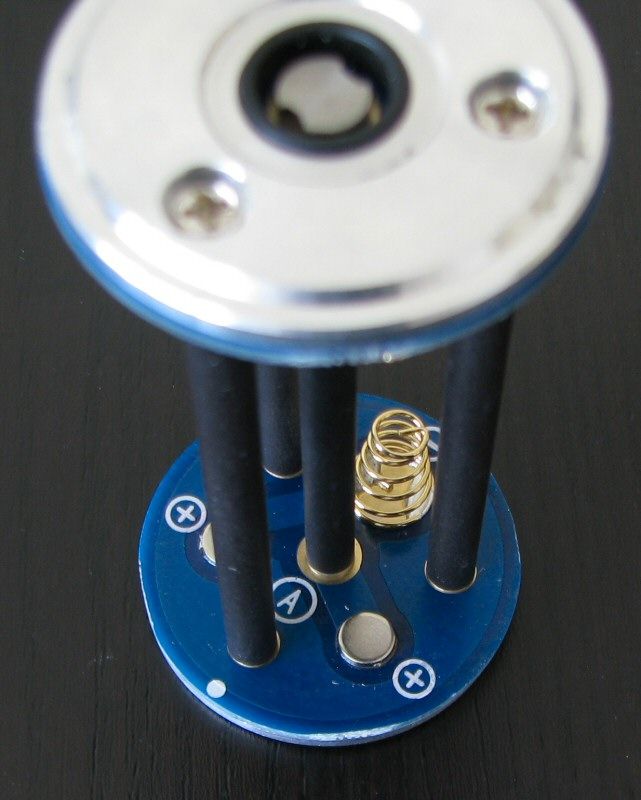
As before, there is a metal battery carrier that holds 3x 18650 cells. While the carrier has been updated slightly, it still looks and functions much as it did before. The three cells are in series (i.e., 3s1p). The positive contact plates remain slightly raised, so all types of 18650 cells should work fine (i.e., true flat-tops, wide and small button-tops). Longer cells may be a bit tight, but my protected 3100mAh cells all fit. The carrier can be inserted either orientation into the handle. Note that particularly wide cells may be a tight fit into the handle.
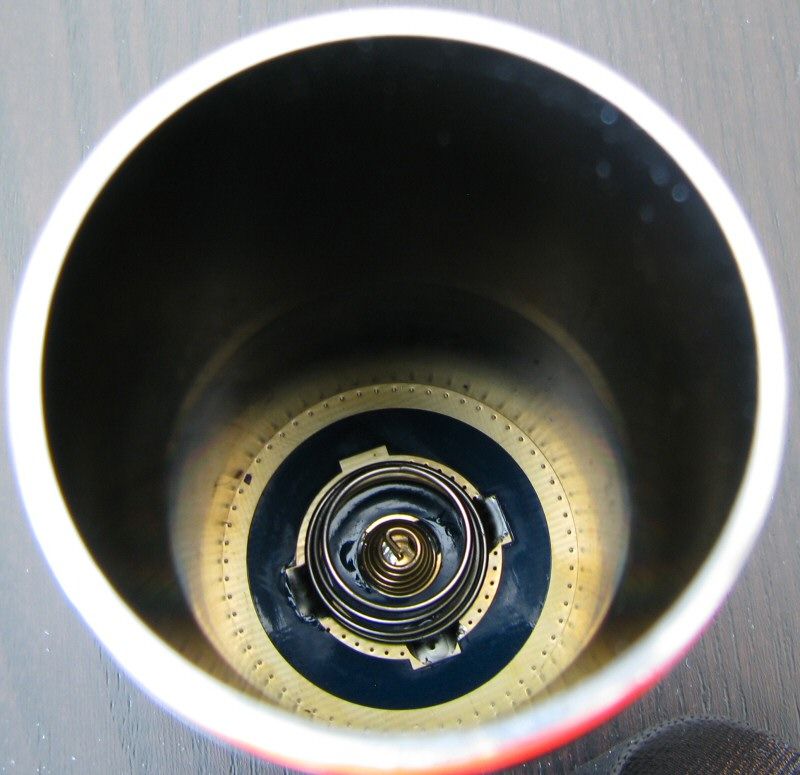
There is a double set of springs in the base, in addition to the spring in the head. The double-set of springs in the tail is a tip-off that something interesting is going on with the tail-switch and the battery carrier.
The light can tailstand stably, and the tailcap cut-outs facilitate access to the switch (style of the cut-outs has been updated somewhat). Switch is the same sort of forward clicky switch as before. But as with the TN31, the switch is a little more complicated than typical. Here is a pic of the switch internals, from my original TN31 review:
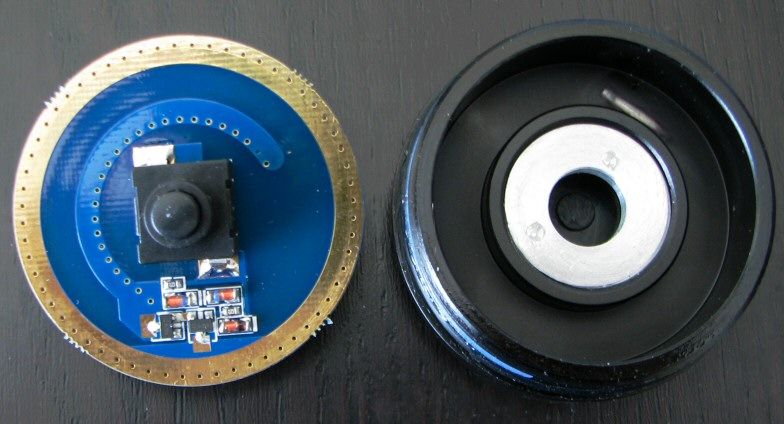
As you can see, there is a circuit along with the forward clicky switch (TN31 shown above, but TN32 should look comparable). As you can imagine, the full current of this heavily-driven light on Max would wreak havoc with a traditional clicky switch in no time. The purpose of the circuit is to provide an assist to the switch, cushioning the load on it. The dual springs in the tail are how it draws power from the battery carrier, irrespective of the head. Scroll down to my Standby Drain section for more info about what this means in terms of current drain.
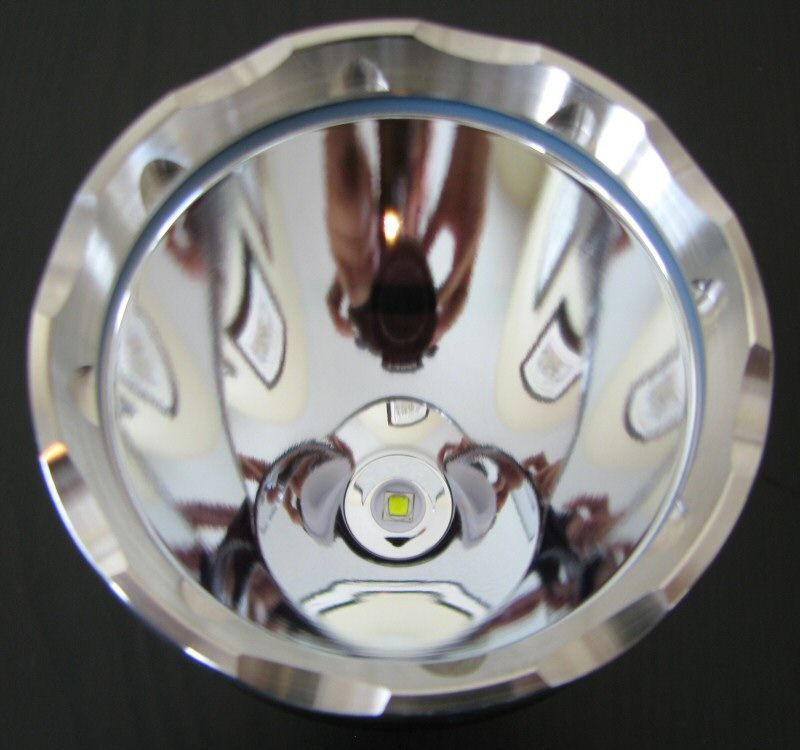
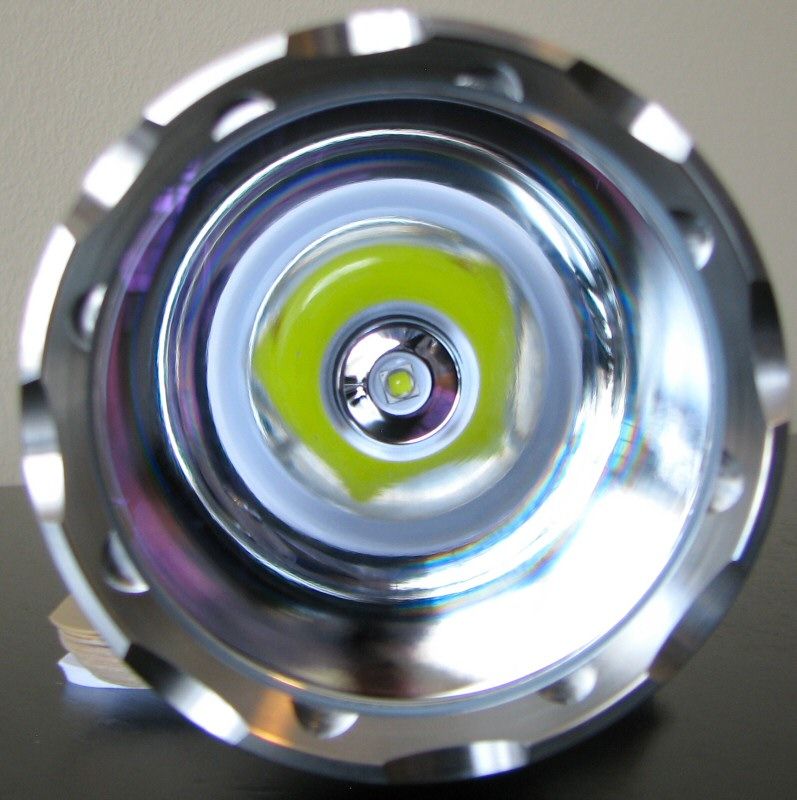
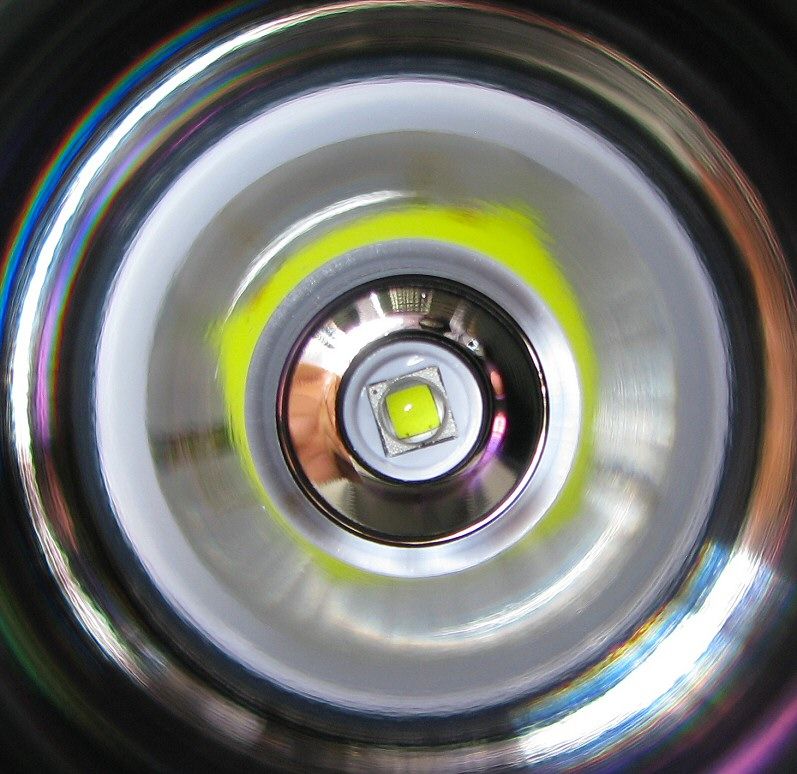
The new XM-L2 emitter was well-centered at the base of a very large and deep reflector on my TN32. The reflector looks even deeper than the original TN31. : ooo: Smooth finish as before, this should provide outstanding throw (given the higher drive level on max on the TN32). There is a good quality anti-glare coating on the lens. The light also has a scalloped stainless steel aluminum bezel ring, as before.
Scroll down for beamshots. :wave:
User Interface
Turn the light off/on by the tailcap clicky – press for momentary, press and release (i.e., click) for constant on.
Change output modes by turning the control ring in the head. Arranged clockwise (i.e., turning from left-to-right with flashlight held in front of you), the modes are level 1 (moonlight) > level 2 > level 3 > level 4 > level 5 > level 6 (max) > standby > tactical strobe.
No light is produced on standby, but a small current will be drawn to allow the circuit to respond to a ring turn (see below).
Video:
For more information on the overall build and user interface of the final shipping BK-FA-series, please see my video overview:
Videos were recorded in 720p, but YouTube typically defaults to 360p. Once the video is running, you can click on the configuration settings icon and select the higher 480p to 720p options. You can also run full-screen.
As with all my videos, I recommend you have annotations turned on. I commonly update the commentary with additional information or clarifications before publicly releasing the video.
PWM/Strobe
There is no sign of PWM on any level – I believe the light is current-controlled.
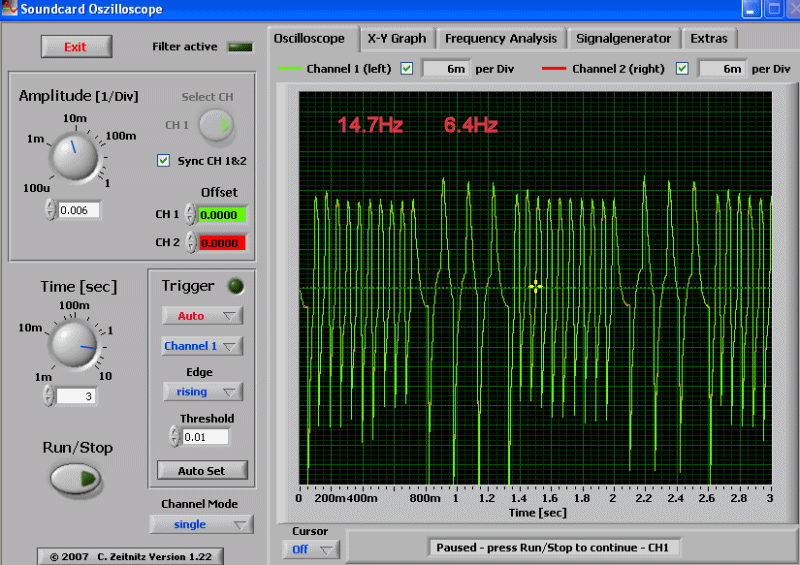
As before, strobe is an oscillating frequency strobe, switching between 6.4Hz and 14.7Hz on my sample. Each frequency lasts for about 2/3 of a sec. Here is a blow-up of each strobe frequency individually:
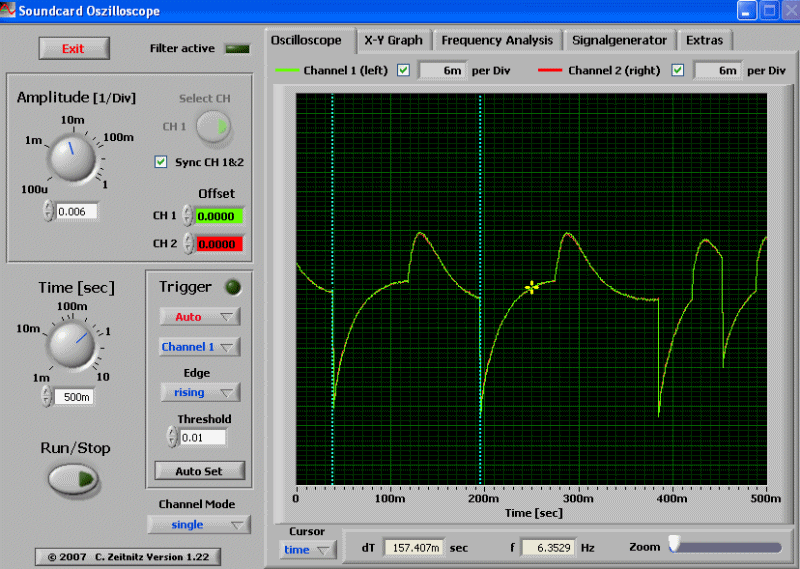
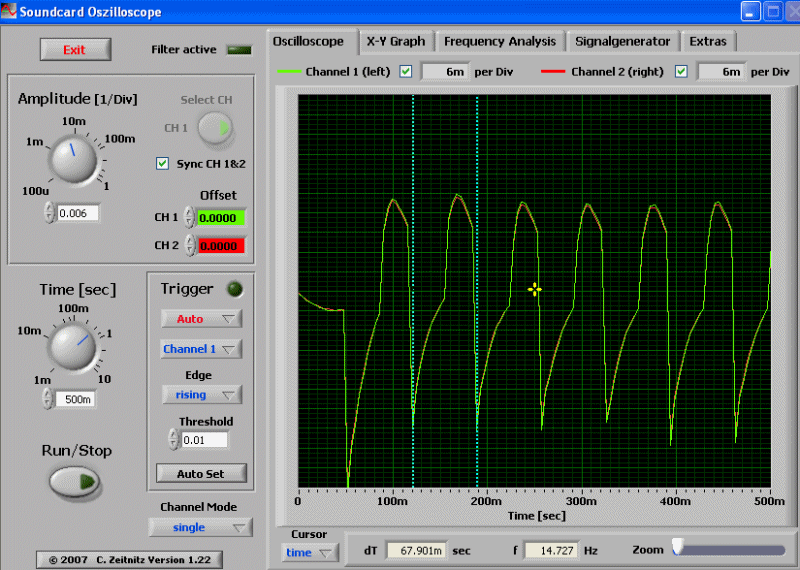
There is a bit of a ramp-up to the peak strobe output, but it is not something you could see in practice. Strobe is quite blazingly fast to the eye.
Standby Drain
There are actually two types of current drain you need to consider here.
Due to the electronic ring control in the head, the TN32 will be drawing a small current when in the "standby" detent with the tailcap switch is clicked on.
I have measured this current as 90uA ion my TN32. Since the cells are arranged in series, for 2600mAh 18650s that that would translate into 3.3 years before the cells would be fully drained. This is quite reasonable for a standby circuit current. And in any case, this current can easily be cut by turning the light off at the tailcap switch.
But due to the switch assist design, there is a secondary circuit in the tailcap that has its own standby drain when a battery carrier is connected. You don't often see physical clicky switches in these sorts of high-powered lights, likely due to their inability to handle the typical current flows. In this case, the physical forward clicky is connected to its own circuit that presumably provides some sort of assist to the switch, modifying the load on it. This means that whenever the battery carrier is loaded with cells and in contact to the tailswitch, a miniscule current will be drawn. I have not measured it at the circuit leads, but I know HKJ reported 20-50uA for the TN31 switch. I presume it is somewhat comparable here, and similarly not a concern (i.e., would take up to a decade to fully drain 18650 cells). Note that to break this current, you would need to actually remove the carrier from the handle.
Either way, these drains are not at all a concern.
Beamshots:
And now, what you have all been waiting for. All lights are on their standard battery, or AW protected 18650 2200mAh for the multi-18650 lights. Lights are about ~0.75 meter from a white wall (with the camera ~1.25 meters back from the wall). Automatic white balance on the camera, to minimize tint differences.
All lights are on their standard battery, or AW protected 18650 2200mAh for the multi-18650 lights. Lights are about ~0.75 meter from a white wall (with the camera ~1.25 meters back from the wall). Automatic white balance on the camera, to minimize tint differences.
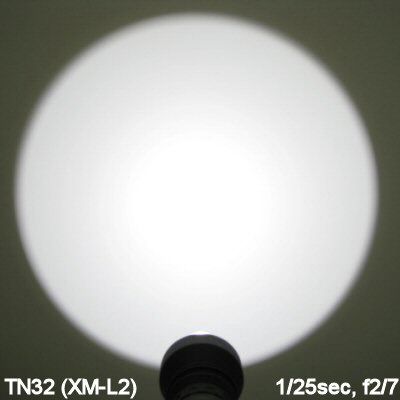
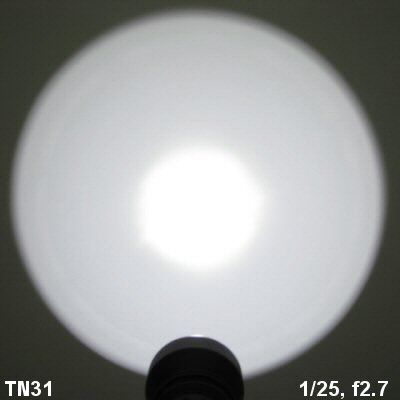
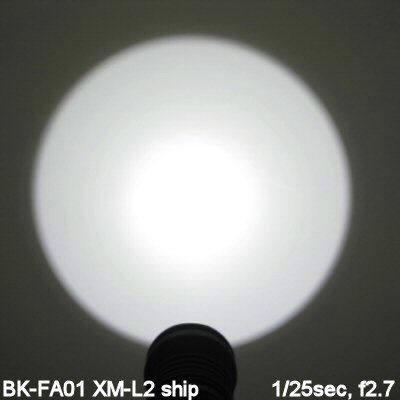
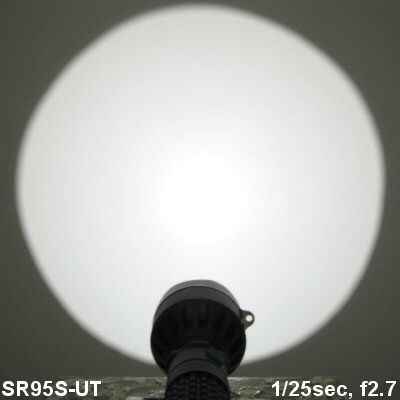
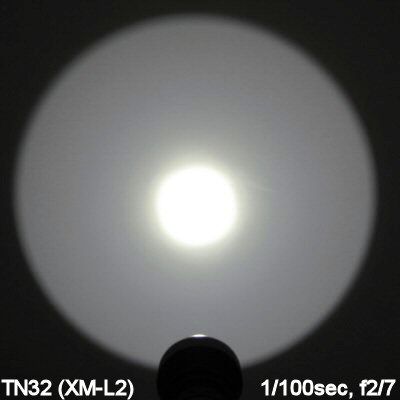
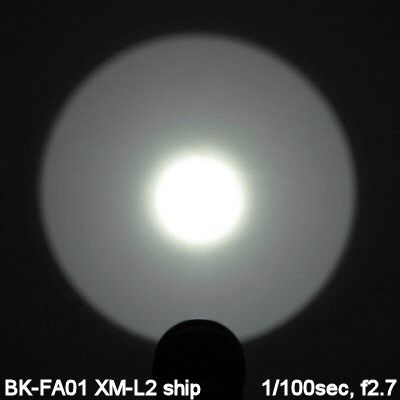
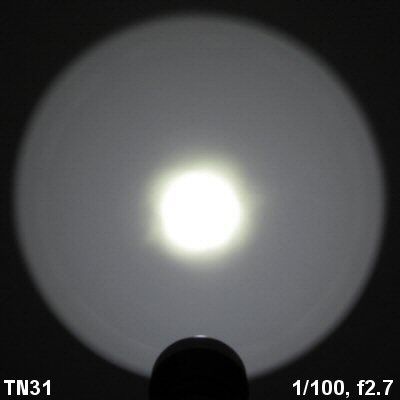
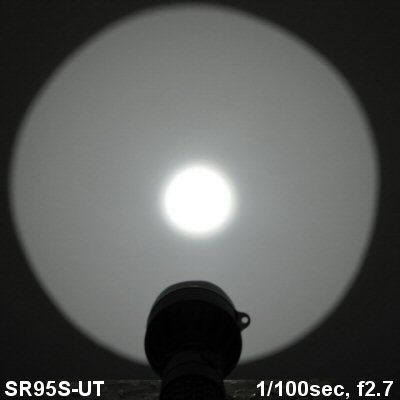
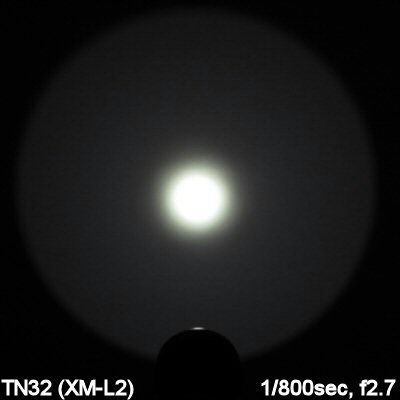
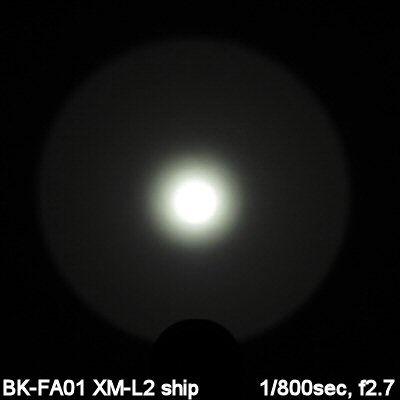
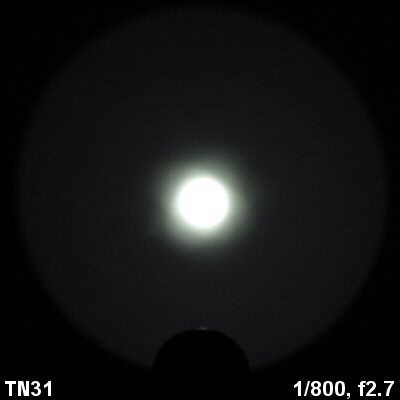
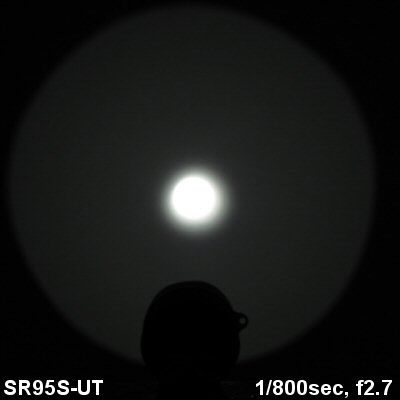
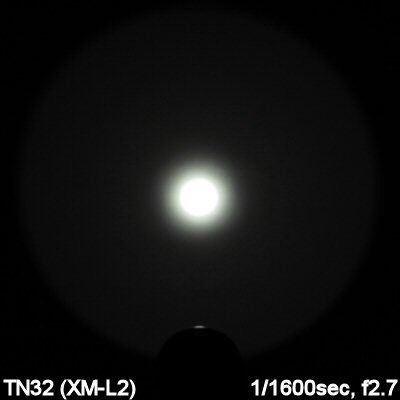
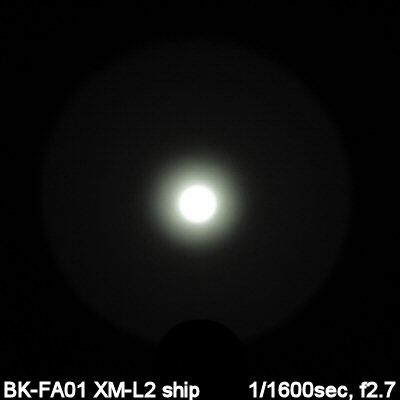
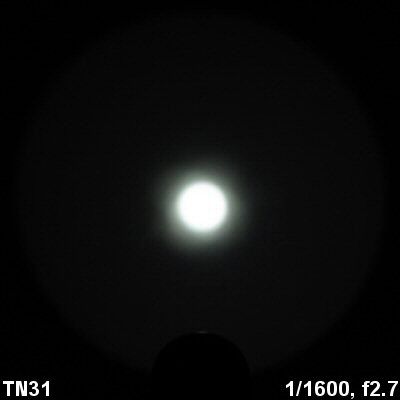
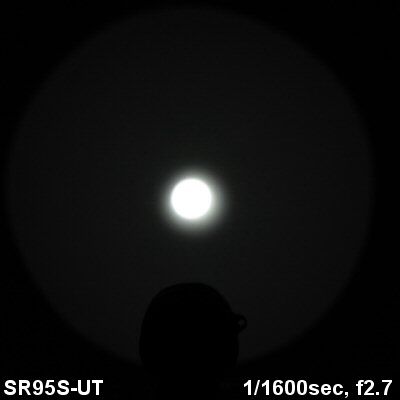
Obviously, it's hard to tell much at such ridiculously close distances. The most obvious observation is that the TN32 certainly has a very focused hotspot, with high intensity. To tell more, we are going to have to go out to further distances ...
The most obvious observation is that the TN32 certainly has a very focused hotspot, with high intensity. To tell more, we are going to have to go out to further distances ... 
Unfortunately, we are still in a middle of a deep freeze here in my part of Canada, with several feet of snow on the ground. As such, outdoor shots would be meaningless (think of snow as equal parts ground-level diffuser and a massive reflector to get the general idea of why outdoor beamshots won't work).
So for now, you will have to make do with some indoor shots in my basement. For your reference, the back of the couch is about 7 feet away (~2.3m) from the opening of the light, and the far wall is about 18 feet away (~5.9m). Below I am showing a couple of exposures, to allow you to better compare hotspot and spill.
Let's see how the TN32 compares to a original TN31, and my more recent 1xXM-L2 throw champ, the Niwalker BK-FA01.
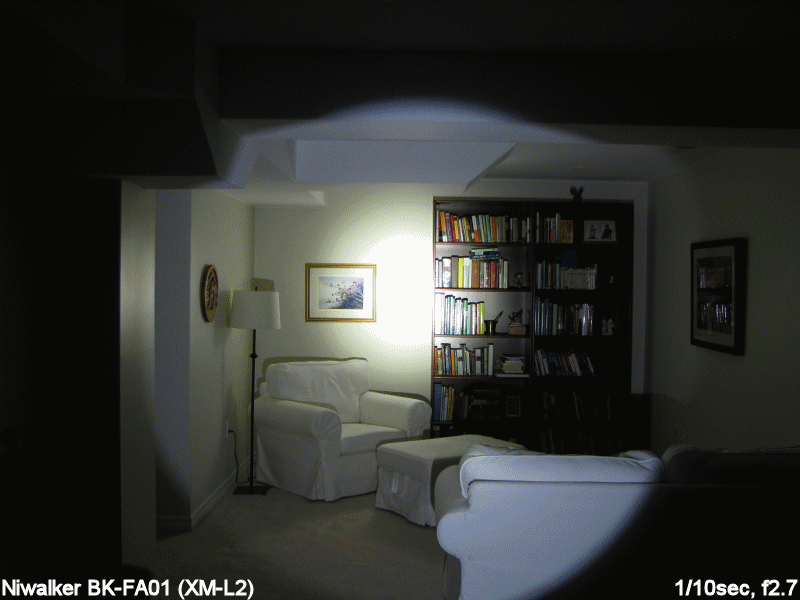
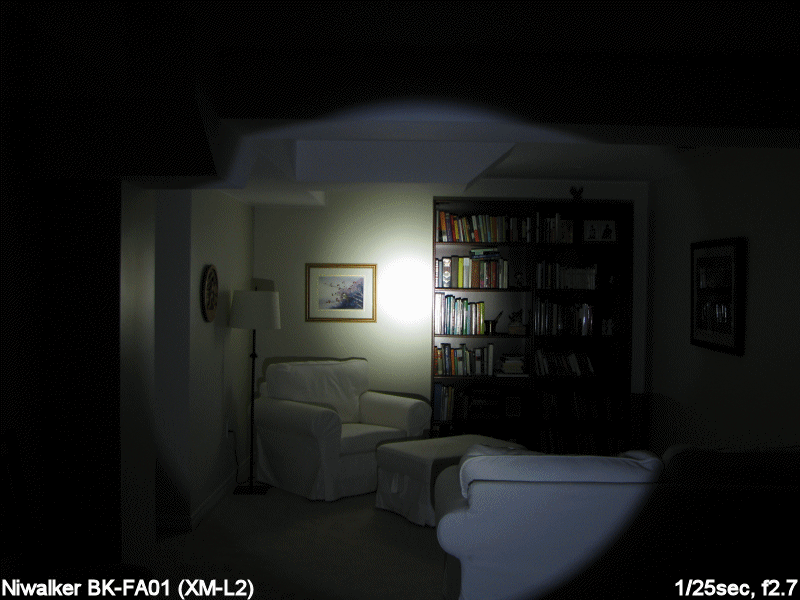
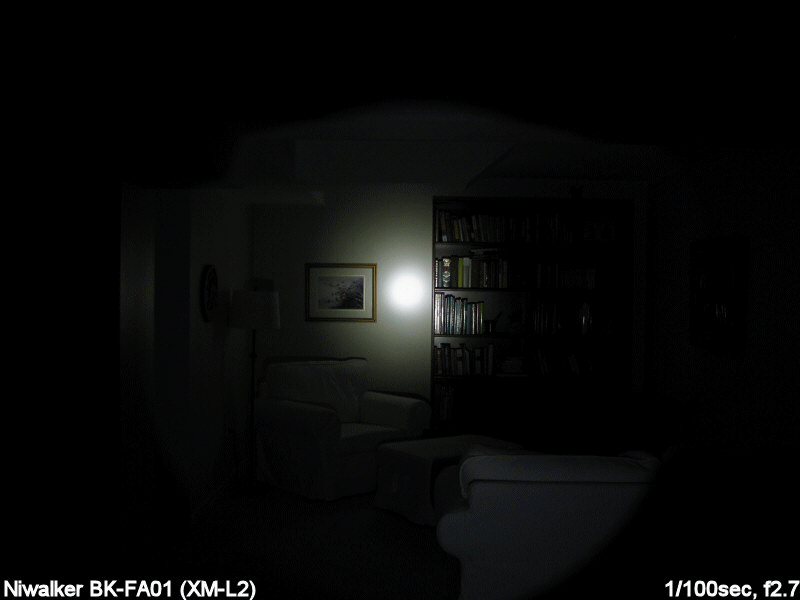
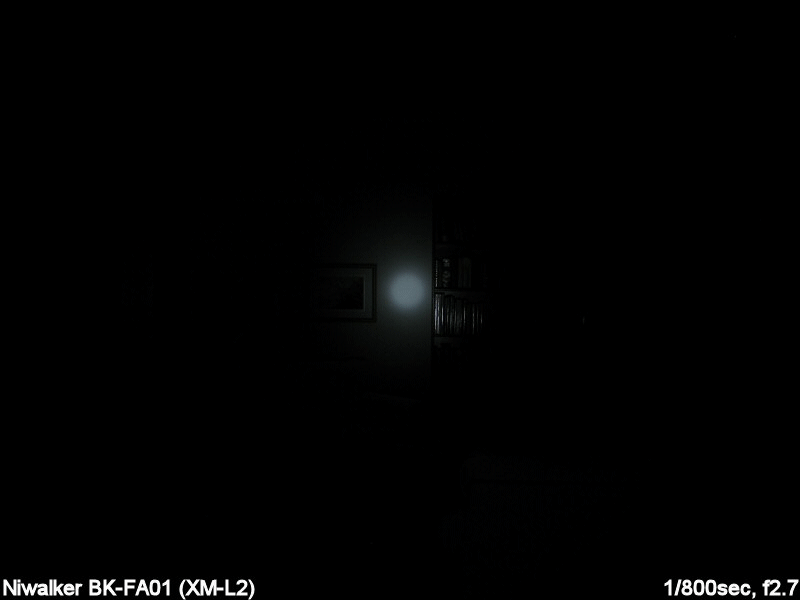
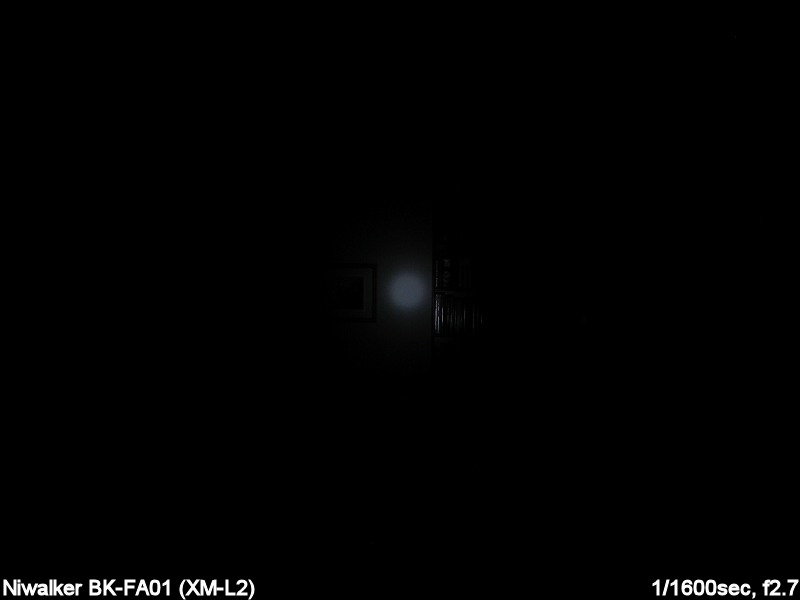
I've done a lot of exposures above so that you can directly compare. The TN32 is clearly the new throw king in this class, with a more focused and brighter hotspot at these distances. This will translate into great total throw distance.
Oh, and you can also tell that the TN32 is brighter overall than the other lights. I can easily say that this is the most heavily driven XM-L2 light I've seen (in stock form). :wave:
UPDATE May 17, 2014: Weather conditions have finally improved enough to start taking outdoor beamshots around here. To start, here is a comparison of the TN35 to the TN32 (XM-L2) and Eagletac SX25L3.
As always, these are done in the style of my earlier 100-yard round-up review. Please see that thread for a discussion of the topography (i.e. the road dips in the distance, to better show you the corona in the mid-ground).
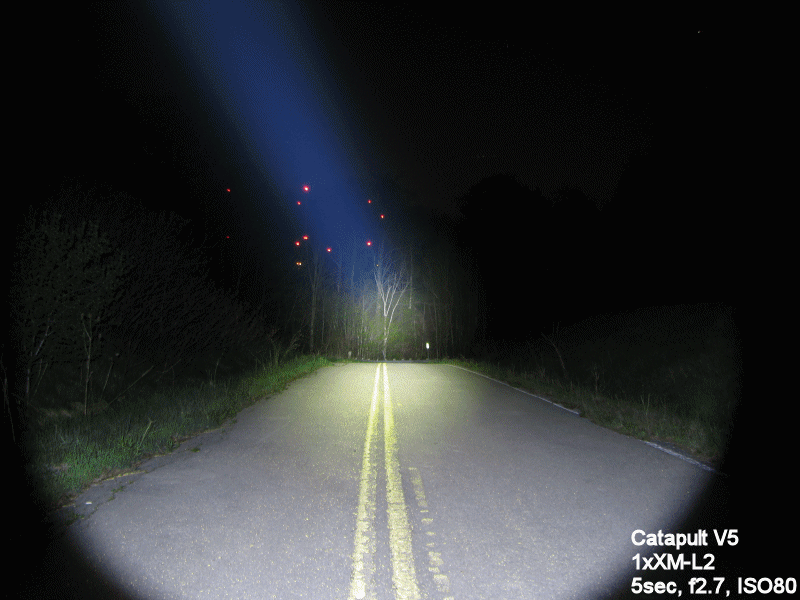

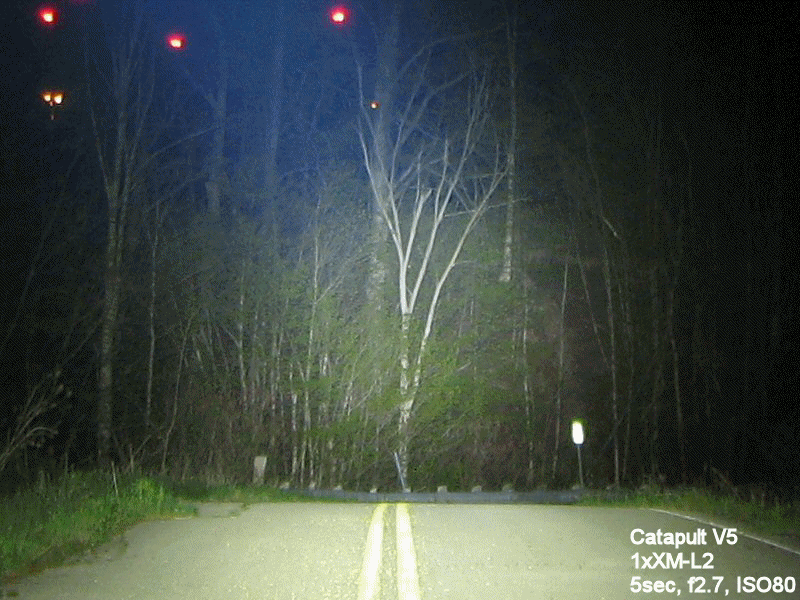
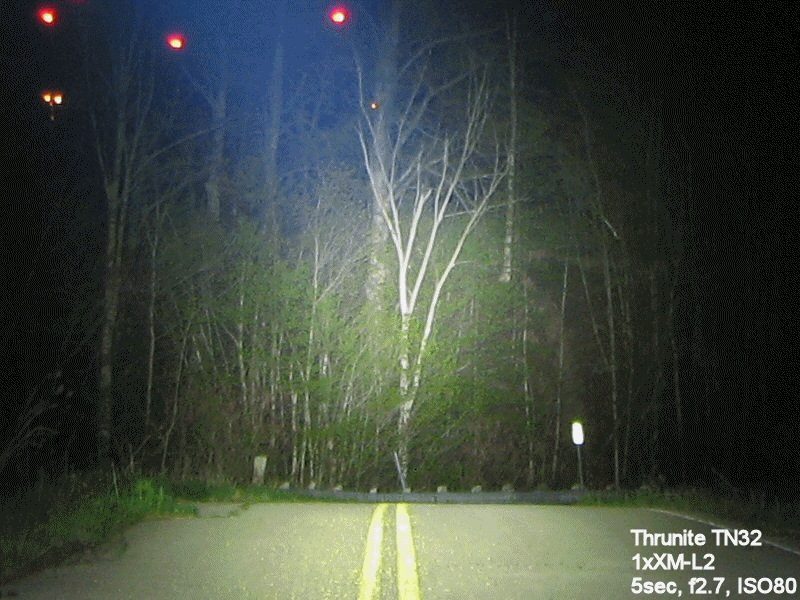
Please note that the color balance of the MT-G2 shots are a little off, as I had automatic white balancing on (i.e., they are not consistent to the adjustment used for the cool white emitters).
The TN32 has an impressive amount of overall output and throw, for a single XM-L2-equipped light. oo: You can see the greater output compared to the stock Fenix TK61 (as well as compared to the Thrunite Catapult V5, although it is closer). Definitely a top stock XM-L2 light. :thumbsup:
oo: You can see the greater output compared to the stock Fenix TK61 (as well as compared to the Thrunite Catapult V5, although it is closer). Definitely a top stock XM-L2 light. :thumbsup:
In terms of the TN35 comparison, the MT-G2 emitter does indeed provide much more of a "wall of light" effect, thanks to the larger emitter. But the deep reflector of the TN32/TN35 build still allows the TN35 to reach out to a good distance (i.e., as compared to the SX25L3, which is obviously struggling at that same distance).
Testing Method:
All my output numbers are relative for my home-made light box setup, as described on my flashlightreviews.ca website. You can directly compare all my relative output values from different reviews - i.e. an output value of "10" in one graph is the same as "10" in another. All runtimes are done under a cooling fan, except for any extended run Lo/Min modes (i.e. >12 hours) which are done without cooling.
I have devised a method for converting my lightbox relative output values (ROV) to estimated Lumens. See my How to convert Selfbuilt's Lightbox values to Lumens thread for more info.
Throw/Output Summary Chart:
My summary tables are reported in a manner consistent with the ANSI FL-1 standard for flashlight testing. Please see http://www.flashlightreviews.ca/FL1.htm for a discussion, and a description of all the terms used in these tables. Effective July 2012, I have updated all my Peak Intensity/Beam Distance measures with a NIST-certified Extech EA31 lightmeter (orange highlights).
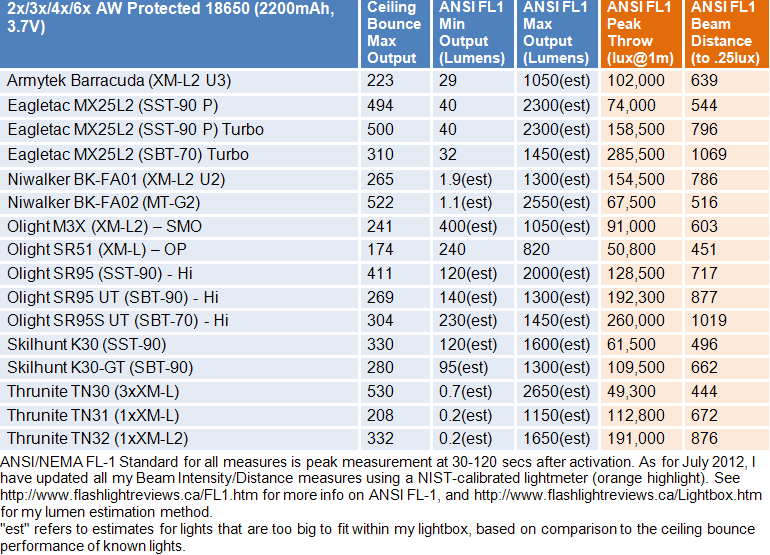
Output has indeed increased from the TN31 – I would estimate it as ~1650 lumens in my setup. And as the beamshots suggested, the TN32 out-throws every other single XM-L2 light I've tested. :bow: It even rivals lights built around the SBT-90 emitter.
My directly measured ANSI FL-1 Peak Intensity of 191,000cd may seem a little low considering the 240,000cd spec, but it's not as far off as you might imagine. First off, it's really more appropriate to compare throwers by ANSI FL-1 Beam Distance. In that sense, the difference between the 980m spec and my 874m is only 11% lower. Given all the variation in circuits, emitters, and precise focusing of the reflector, that difference isn't so unreasonable.
Something else to keep in mind is when exactly you need to measure. The ANSI FL-1 standards of Peak Intensity and Peak Distance are based on the highest measure taken during 30secs to 2mins post-activation. Here is a breakdown of what I directly measured on my NIST-certified light meter, working back from a 10m distance, taken at 15 sec intervals (shown as min:sec below). Batteries are three Redilast 2600mAh (Sanyo cells), charged to ~4.21V to start.
0:15 - 194,000cd
0:30 - 191,000cd
0:45 - 188,500cd
1:00 - 188,000cd
1:15 - 174,500cd
1:30 - 175,000cd
1:45 - 174,500cd
2:00 – 174,000cd
As you can tell, output (as indicated by throw) drops somewhat over the first minute, but then drops to a more consistent level once step-down occurs between 1:00 and 1:15 mins post-activation (see below for more info). I didn't measure directly at initial activation, but I presume that would have been pretty close to ~200,000cd on my sample. But by the ANSI FL-1 standard, throw for my sample is 191,000cd.
Here is a breakdown of the estimated lumen values for both the TN31 and TN32 in my testing:
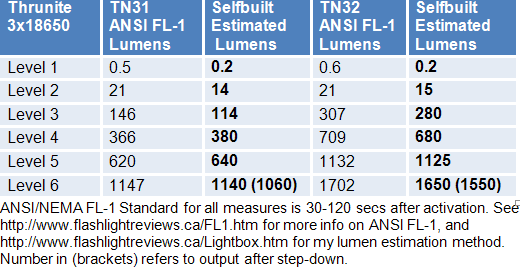
As you can see, the reported output and throw specs from Thrunite seem remarkably consistent with my testing. I suspect Thrunite did indeed get these tested in a properly-calibrated integrating sphere. :thumbsup:
Step-down occurs on L6 after 70 secs of runtime.
As with the TN31, the lowest output of my sample is slightly lower than 0.6 lumens in my testing. I would estimate around 0.2 lumens in fact.
Output/Runtime Graphs:
Let's start with a comparison of the top four output modes:
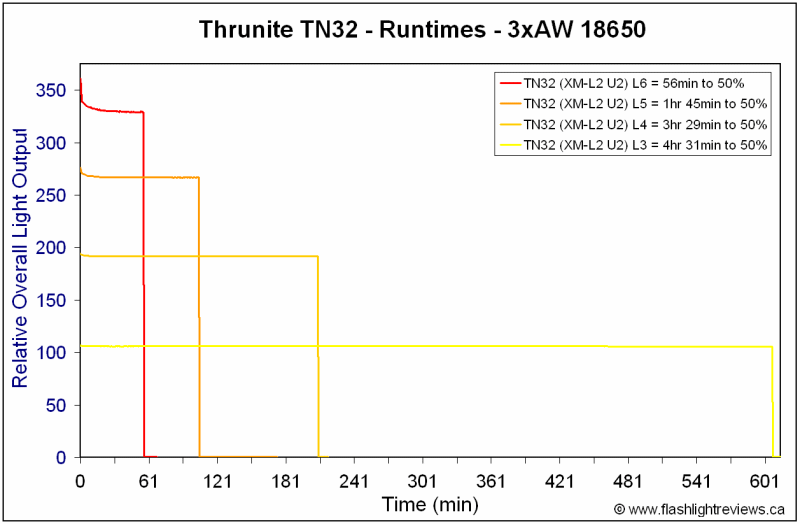
Nothing very surprising – you get excellent flat regulation on all levels. :thumbsup:
Note that all my runtimes are done under a cooling fan. It is therefore reasonable to consider what would happen with no cooling (although I suggest the cramped corner of my office is not representational of the wider world). For this test, I attached a thermal probe to the middle of the chrome-plate heatsink base for concurrent measures.
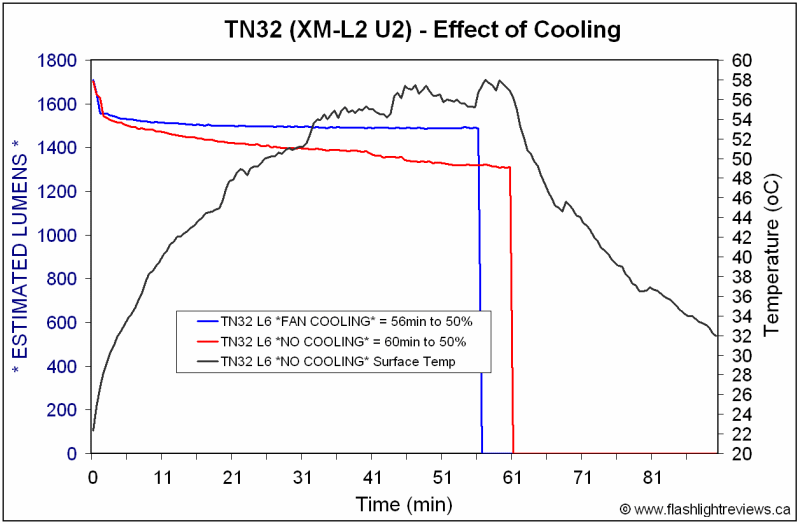
Note for this run I converted my relative output measures to estimated lumens, to allow you to better compare output changes over time (left y-axis above). The right y-axis is the surface temperature in degrees centigrade (celcius), for the non-cooled run. It is hard to put those numbers in context since I don't usually measure temp, but subjectively I can tell you the light gets quite hot.
As you can see, the lack of cooling caused a small drop in output over time - but nothing you could ever see visually. This did result in marginally longer runtime, of course.
As always, take my lumen estimates with a grain of salt - they are based on a calibration of my lightbox to ceiling bounce values of other heavy output lights of known calibrated lumens. But they do seem consistent with Thrunite specs.
Let's see how the TN32 stacks up against the original TN31, and "thrower" style XM-L2 lights.
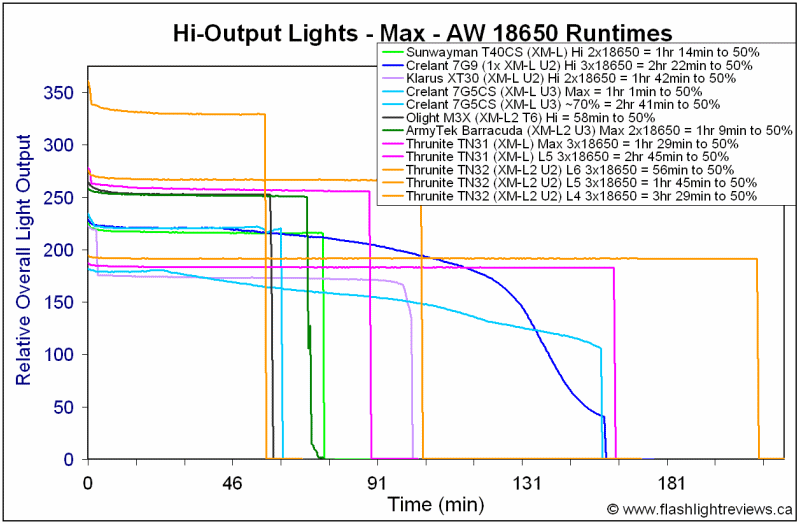
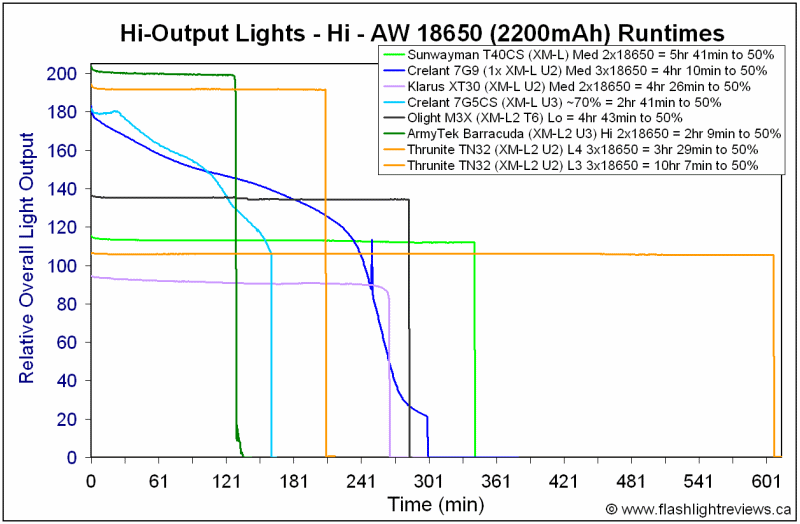
The TN32's L6 mode is brighter than the old TN31 – in fact, the old TN31 L6 is comparable to the new TN32 L5, and the TN31 L5 is comparable to the new TN32 L4 (as you saw in the output table summary). The new TN32 definitely runs for longer than the old TN31, at comparable output.
It's a bit hard to compare the TN32 to most of the other lights, since they are typically 2x18650. But the TN32 certainly seem to be an efficiency champ, with incredibly long relative runtimes. :thumbsup:
Let's see how it does against the larger 3x/4x18650 lights:
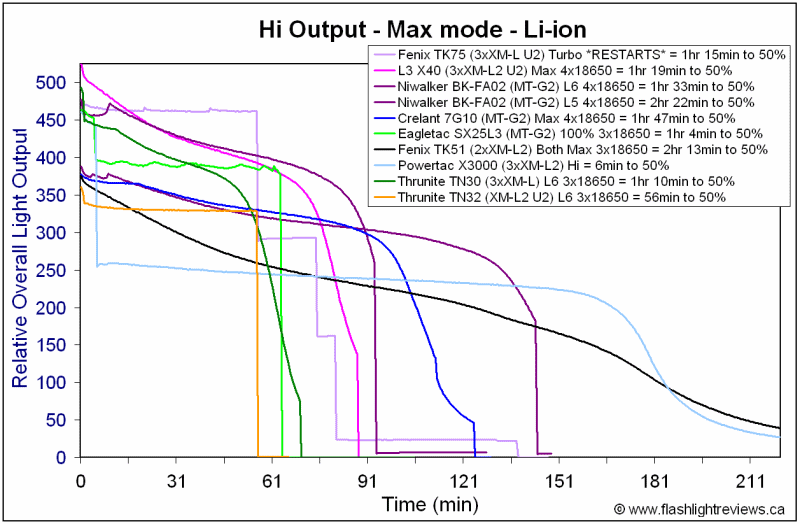
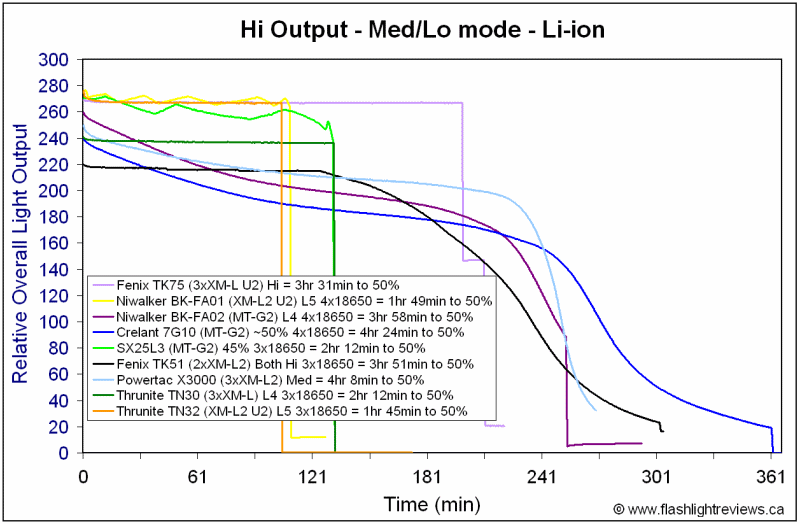
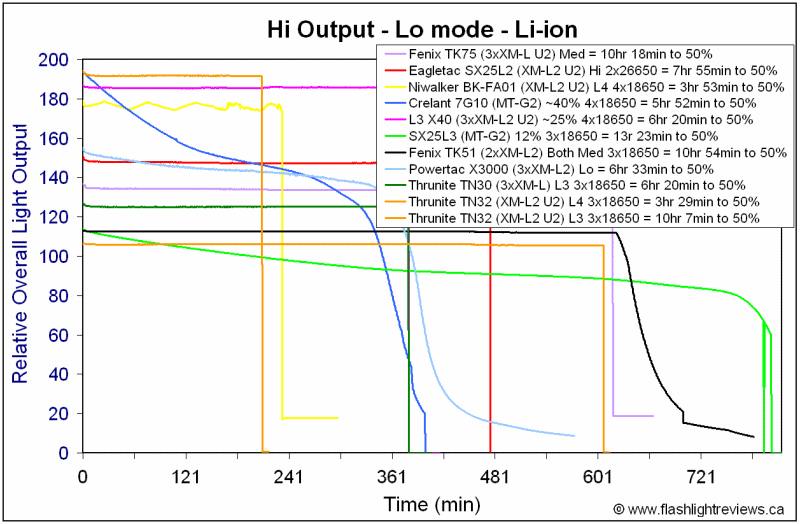
As you would expect, at the highest level, the 1xXM-L2 TN32 can't really compete with the multi-emitter lights (for either output or runtime). But it surprisingly holds its own quite well at the lower levels, even against some of the 4x18650 lights. Overall efficiency is thus again quite impressive for this class.
Potential Issues
Due to the electronic control ring in the head, the light has a stand-by current when in "Stand By" mode. But this current is very low (90uA), and will not be problem for regular use. You can break this current by clicking the tailswitch off.
There is a second standby current due a circuit in the tail to assist the physical switch. The tail circuit draws its power directly from the battery carrier, irrespective to the state of the head (i.e., the purpose of those dual springs in the tail). The current draw is miniscule, and has been measured by others in the low uA range (i.e., would take many years to fully drain the cells). The only way to break it is to remove the battery carrier from the handle, however.
You can no longer lock the light out at the head (to prevent accidental activation)
Only 3x 318650 Li-ion cells may be used in the light (i.e., doesn't support multiple CR123A primary cells)
Light uses a battery carrier, and very long or wide cells may be a bit tight. But all cells I tested worked in the carrier, including protected flat-top cells.
Preliminary Observations
The TN32 is a worthy upgrade to the TN31. Building on the considerable success of that earlier model, Thrunite has increased both output and throw, making the TN32 the furthest throwing 1xXM-L2 in my collection at the moment (in stock form). :bow:
Physically, the main difference from the TN31 is the new brass heatsink for the circuit housing (which you can see by its chrome-plate experior). This obviously allows Thrunite to drive the TN32's XM-L2 emitter to higher levels. The impressively deep reflector on the TN31 seems to be even slightly longer now.
As before, output/runtime performance was excellent for the TN32, with its the current-control circuitry providing outstanding runtimes at all levels tested. Stabilization was quite good as before, with perfectly flat regulation on all levels (after a minor step-down on max). :thumbsup: As with the TN31, the TN32 drops to a low moonlight level once the batteries reach the end of their runs.
I was always a fan of the control ring interface on this model, and I'm glad to see Thrunite has left that unchanged (except for increasing most of the output levels, of course). The ring has clear and firm detents, and the output levels are well spaced.
The battery carrier has had a few minor updates, but is largely unchanged. Same for the physical clicky switch for on/off. It is rare to see an actual physical clicky switch on these sorts of high-powered lights – the TN-series models accomplish this by a bit of boost-assist circuitry. The standby current draw remains tiny.
The TN31 quickly became a popular substrate for modders, who swapped out its guts and improved thermal conductivity. By incorporating a brass heatsink right into the new TN32 design, Thrunte is basically giving you a partial custom redesign of its own model. For those looking for maximum throw and output from a single XM-L2 emitter – in a stock form light – I think the TN32 is the answer for now. :wave:
----
TN32 provided by Thrunite for review.
Warning: even more pic heavy than usual.



Thrunite has sent me their updated 1xXM-L2, 3x18650 "thrower" light, now known as the TN32. The likely reason for the new model number is the significant internal build differences from the old TN31 that I reviewed previously.
Let's see how it compares …
Manufacturer Reported Specifications:
(note: as always, these are simply what the manufacturer provides – scroll down to see my actual testing results).
- LED: Cree XM-L2 U2 LED
- Max 1702 lumen output using 3 * 18650 batteries
- Level 1: 0.6 lm/80 days; Level 2: 21 lm/7 days; Level 3: 307 lm/11.5 hours; Level 4: 709 lm/4 hours; Level 5: 1132 lm/2 hours; Level 6: 1702 lm/1.5 hours; Strobe: 2 hours.
- Working voltage: 8V-13V.
- Max Runtime: 2000 hours
- Max beam distance: 979 meters
- Peak beam intensity: 240,000cd
- Impact resistant: 1.2 meters.
- Waterproof to IPX-8 standard, 2M.
- Dimensions: 201.70mm length, 79mm bezel diameter.
- Weight: 650g (without batteries)
- Copper circuit provides better heat dissipation performance
- Improved UI for more lumens
- Ultra-clear tempered glass lens with anti-reflective coating.
- Reverse polarity protection design
- Momentary forward click tactical switch.
- Strobe mode for tactical and emergency use.
- Smooth reflector for max light output.
- Highly focused beam for maximum distance
- Tactical knurling for firm grip.
- Aircraft grade aluminum body.
- Streamlined body design.
- Mechanical reversed polarity protection design for battery carrier.
- Intelligent highly efficient circuit board design for max performance and long run time.
- Specially designed for Military, Law Enforcement, Self-defense, Hunting, Search & Rescue and Outdoor activities.
- Intelligent temperature controlled light output for user safety.
- Include accessories: Holster, Lanyard, User's Manual, Warranty card, extra o-ring.
- MSRP: $180



Packaging has been updated slightly, but is generally not that different. The TN32 still comes in a presentation case, with metal hinges and closing clasps. Inside are the light, belt pouch, wrist lanyard, manual, warranty card, and extra o-rings and spare boot cover.



From left to right: AW Protected 18650 2200mAh; Thrunite TN32, TN31; Niwalker Vostro BK-FA01; L3 Illumination X40; Fenix TK51.
All dimensions directly measured, and given with no batteries installed (unless indicated):
Thrunite TN32 (XM-L2): Weight: 655.9g (808g with 3x18650), Length: 201mm, Width (bezel): 79.0mm
Thrunite TN31 (XM-L): Weight: 572g (est 724g with 3x18650), Length: 203mm, Width (bezel): 79.0mm
ArmyTek Barracuda (XM-L2): Weight 400.8g, Length 264mm, Width (bezel): 64.0mm
Eagletac MX25L2 Turbo (SBT-70):Weight: 698.6g (with battery pack: 974.1g), Length: 292mm, Width (bezel): 91.3mm
Niwalker BK-FA01 (XM-L2): Weight: 682.3g (864g with 4x18650), Length: 209mm, Width (bezel): 80.0mm, Width (tailcap): 50.3mm
Olight SR95S-UT (SBT-70): Weight: 1,208g (with battery pack), Length: 323mm, Width (bezel): 87mm
Olight SR95-UT (SBT-90): Weight: 1,221g (with battery pack), Length: 323mm, Width (bezel): 87mm
Skilhunt K30-GT (SBT-90): Weight: 635.9g (773g with 3x18650), Length: 199m, Width (bezel): 76.0mm
As you can see, weight has increased on the TN32, without appreciable changes in the dimensions (compared to the TN31).



As before, overall anodizing is a glossy black. Quality seems very good as always, there were no chips or damage on my sample. Labels were sharp and bright white against the black background. Knurling is fairly aggressive on the handle, helping with grip.
One difference I noticed - screw threads are no longer anodized for head lock-out. I suspect this change has to do with the new brass heatsink module in the head (see discussion below). Threads are standard triangular cut, but seem of good quality.
The control ring feels much like before, with detents for the various defined modes (and cut-out indentations on the ring itself, to help with grip). The main external change to the light is the base of the head – rather than regular black anodized aluminum, there is now a smooth, shiny, chrome-plated brass heatsink. Labels for the control ring indicator arrow are now on this chrome-plated area, as shown below.



As before, the six constant output modes are not individually labeled, but there is a graded output bar pictogram over the first couple of levels (i.e., shows the direction to turn to raise or lower the output). Scroll down to my User Interface and Standby Drain sections for a discussion of how the light works.
While the chrome-plating provides a bit of bling, the real difference to the light is the brass underneath. Encasing the emitter and circuit housing, this should provide for much better thermal transfer (allowing for higher drive levels, and thus higher maximum output). It likely also explains the much greater weight of the TN32 over the TN31.
As an aside, the TN31 was a very popular build for modders here, who could provide a custom light engine with improved heatsinking. The TN32 may thus be seen as an attempt to turn a mass-produced light into something of a "hot-rod" model by default. :devil:
Let's look at the carrier:





As before, there is a metal battery carrier that holds 3x 18650 cells. While the carrier has been updated slightly, it still looks and functions much as it did before. The three cells are in series (i.e., 3s1p). The positive contact plates remain slightly raised, so all types of 18650 cells should work fine (i.e., true flat-tops, wide and small button-tops). Longer cells may be a bit tight, but my protected 3100mAh cells all fit. The carrier can be inserted either orientation into the handle. Note that particularly wide cells may be a tight fit into the handle.

There is a double set of springs in the base, in addition to the spring in the head. The double-set of springs in the tail is a tip-off that something interesting is going on with the tail-switch and the battery carrier.
The light can tailstand stably, and the tailcap cut-outs facilitate access to the switch (style of the cut-outs has been updated somewhat). Switch is the same sort of forward clicky switch as before. But as with the TN31, the switch is a little more complicated than typical. Here is a pic of the switch internals, from my original TN31 review:

As you can see, there is a circuit along with the forward clicky switch (TN31 shown above, but TN32 should look comparable). As you can imagine, the full current of this heavily-driven light on Max would wreak havoc with a traditional clicky switch in no time. The purpose of the circuit is to provide an assist to the switch, cushioning the load on it. The dual springs in the tail are how it draws power from the battery carrier, irrespective of the head. Scroll down to my Standby Drain section for more info about what this means in terms of current drain.



The new XM-L2 emitter was well-centered at the base of a very large and deep reflector on my TN32. The reflector looks even deeper than the original TN31. : ooo: Smooth finish as before, this should provide outstanding throw (given the higher drive level on max on the TN32). There is a good quality anti-glare coating on the lens. The light also has a scalloped stainless steel aluminum bezel ring, as before.
Scroll down for beamshots. :wave:
User Interface
Turn the light off/on by the tailcap clicky – press for momentary, press and release (i.e., click) for constant on.
Change output modes by turning the control ring in the head. Arranged clockwise (i.e., turning from left-to-right with flashlight held in front of you), the modes are level 1 (moonlight) > level 2 > level 3 > level 4 > level 5 > level 6 (max) > standby > tactical strobe.
No light is produced on standby, but a small current will be drawn to allow the circuit to respond to a ring turn (see below).
Video:
For more information on the overall build and user interface of the final shipping BK-FA-series, please see my video overview:
Videos were recorded in 720p, but YouTube typically defaults to 360p. Once the video is running, you can click on the configuration settings icon and select the higher 480p to 720p options. You can also run full-screen.
As with all my videos, I recommend you have annotations turned on. I commonly update the commentary with additional information or clarifications before publicly releasing the video.
PWM/Strobe
There is no sign of PWM on any level – I believe the light is current-controlled.

As before, strobe is an oscillating frequency strobe, switching between 6.4Hz and 14.7Hz on my sample. Each frequency lasts for about 2/3 of a sec. Here is a blow-up of each strobe frequency individually:


There is a bit of a ramp-up to the peak strobe output, but it is not something you could see in practice. Strobe is quite blazingly fast to the eye.
Standby Drain
There are actually two types of current drain you need to consider here.
Due to the electronic ring control in the head, the TN32 will be drawing a small current when in the "standby" detent with the tailcap switch is clicked on.
I have measured this current as 90uA ion my TN32. Since the cells are arranged in series, for 2600mAh 18650s that that would translate into 3.3 years before the cells would be fully drained. This is quite reasonable for a standby circuit current. And in any case, this current can easily be cut by turning the light off at the tailcap switch.
But due to the switch assist design, there is a secondary circuit in the tailcap that has its own standby drain when a battery carrier is connected. You don't often see physical clicky switches in these sorts of high-powered lights, likely due to their inability to handle the typical current flows. In this case, the physical forward clicky is connected to its own circuit that presumably provides some sort of assist to the switch, modifying the load on it. This means that whenever the battery carrier is loaded with cells and in contact to the tailswitch, a miniscule current will be drawn. I have not measured it at the circuit leads, but I know HKJ reported 20-50uA for the TN31 switch. I presume it is somewhat comparable here, and similarly not a concern (i.e., would take up to a decade to fully drain 18650 cells). Note that to break this current, you would need to actually remove the carrier from the handle.
Either way, these drains are not at all a concern.
Beamshots:
And now, what you have all been waiting for.
















Obviously, it's hard to tell much at such ridiculously close distances.
Unfortunately, we are still in a middle of a deep freeze here in my part of Canada, with several feet of snow on the ground. As such, outdoor shots would be meaningless (think of snow as equal parts ground-level diffuser and a massive reflector to get the general idea of why outdoor beamshots won't work).
So for now, you will have to make do with some indoor shots in my basement. For your reference, the back of the couch is about 7 feet away (~2.3m) from the opening of the light, and the far wall is about 18 feet away (~5.9m). Below I am showing a couple of exposures, to allow you to better compare hotspot and spill.
Let's see how the TN32 compares to a original TN31, and my more recent 1xXM-L2 throw champ, the Niwalker BK-FA01.





I've done a lot of exposures above so that you can directly compare. The TN32 is clearly the new throw king in this class, with a more focused and brighter hotspot at these distances. This will translate into great total throw distance.
Oh, and you can also tell that the TN32 is brighter overall than the other lights. I can easily say that this is the most heavily driven XM-L2 light I've seen (in stock form). :wave:
UPDATE May 17, 2014: Weather conditions have finally improved enough to start taking outdoor beamshots around here. To start, here is a comparison of the TN35 to the TN32 (XM-L2) and Eagletac SX25L3.
As always, these are done in the style of my earlier 100-yard round-up review. Please see that thread for a discussion of the topography (i.e. the road dips in the distance, to better show you the corona in the mid-ground).




Please note that the color balance of the MT-G2 shots are a little off, as I had automatic white balancing on (i.e., they are not consistent to the adjustment used for the cool white emitters).
The TN32 has an impressive amount of overall output and throw, for a single XM-L2-equipped light.
In terms of the TN35 comparison, the MT-G2 emitter does indeed provide much more of a "wall of light" effect, thanks to the larger emitter. But the deep reflector of the TN32/TN35 build still allows the TN35 to reach out to a good distance (i.e., as compared to the SX25L3, which is obviously struggling at that same distance).
Testing Method:
All my output numbers are relative for my home-made light box setup, as described on my flashlightreviews.ca website. You can directly compare all my relative output values from different reviews - i.e. an output value of "10" in one graph is the same as "10" in another. All runtimes are done under a cooling fan, except for any extended run Lo/Min modes (i.e. >12 hours) which are done without cooling.
I have devised a method for converting my lightbox relative output values (ROV) to estimated Lumens. See my How to convert Selfbuilt's Lightbox values to Lumens thread for more info.
Throw/Output Summary Chart:
My summary tables are reported in a manner consistent with the ANSI FL-1 standard for flashlight testing. Please see http://www.flashlightreviews.ca/FL1.htm for a discussion, and a description of all the terms used in these tables. Effective July 2012, I have updated all my Peak Intensity/Beam Distance measures with a NIST-certified Extech EA31 lightmeter (orange highlights).

Output has indeed increased from the TN31 – I would estimate it as ~1650 lumens in my setup. And as the beamshots suggested, the TN32 out-throws every other single XM-L2 light I've tested. :bow: It even rivals lights built around the SBT-90 emitter.
My directly measured ANSI FL-1 Peak Intensity of 191,000cd may seem a little low considering the 240,000cd spec, but it's not as far off as you might imagine. First off, it's really more appropriate to compare throwers by ANSI FL-1 Beam Distance. In that sense, the difference between the 980m spec and my 874m is only 11% lower. Given all the variation in circuits, emitters, and precise focusing of the reflector, that difference isn't so unreasonable.
Something else to keep in mind is when exactly you need to measure. The ANSI FL-1 standards of Peak Intensity and Peak Distance are based on the highest measure taken during 30secs to 2mins post-activation. Here is a breakdown of what I directly measured on my NIST-certified light meter, working back from a 10m distance, taken at 15 sec intervals (shown as min:sec below). Batteries are three Redilast 2600mAh (Sanyo cells), charged to ~4.21V to start.
0:15 - 194,000cd
0:30 - 191,000cd
0:45 - 188,500cd
1:00 - 188,000cd
1:15 - 174,500cd
1:30 - 175,000cd
1:45 - 174,500cd
2:00 – 174,000cd
As you can tell, output (as indicated by throw) drops somewhat over the first minute, but then drops to a more consistent level once step-down occurs between 1:00 and 1:15 mins post-activation (see below for more info). I didn't measure directly at initial activation, but I presume that would have been pretty close to ~200,000cd on my sample. But by the ANSI FL-1 standard, throw for my sample is 191,000cd.
Here is a breakdown of the estimated lumen values for both the TN31 and TN32 in my testing:

As you can see, the reported output and throw specs from Thrunite seem remarkably consistent with my testing. I suspect Thrunite did indeed get these tested in a properly-calibrated integrating sphere. :thumbsup:
Step-down occurs on L6 after 70 secs of runtime.
As with the TN31, the lowest output of my sample is slightly lower than 0.6 lumens in my testing. I would estimate around 0.2 lumens in fact.
Output/Runtime Graphs:
Let's start with a comparison of the top four output modes:

Nothing very surprising – you get excellent flat regulation on all levels. :thumbsup:
Note that all my runtimes are done under a cooling fan. It is therefore reasonable to consider what would happen with no cooling (although I suggest the cramped corner of my office is not representational of the wider world). For this test, I attached a thermal probe to the middle of the chrome-plate heatsink base for concurrent measures.

Note for this run I converted my relative output measures to estimated lumens, to allow you to better compare output changes over time (left y-axis above). The right y-axis is the surface temperature in degrees centigrade (celcius), for the non-cooled run. It is hard to put those numbers in context since I don't usually measure temp, but subjectively I can tell you the light gets quite hot.
As you can see, the lack of cooling caused a small drop in output over time - but nothing you could ever see visually. This did result in marginally longer runtime, of course.
As always, take my lumen estimates with a grain of salt - they are based on a calibration of my lightbox to ceiling bounce values of other heavy output lights of known calibrated lumens. But they do seem consistent with Thrunite specs.
Let's see how the TN32 stacks up against the original TN31, and "thrower" style XM-L2 lights.


The TN32's L6 mode is brighter than the old TN31 – in fact, the old TN31 L6 is comparable to the new TN32 L5, and the TN31 L5 is comparable to the new TN32 L4 (as you saw in the output table summary). The new TN32 definitely runs for longer than the old TN31, at comparable output.
It's a bit hard to compare the TN32 to most of the other lights, since they are typically 2x18650. But the TN32 certainly seem to be an efficiency champ, with incredibly long relative runtimes. :thumbsup:
Let's see how it does against the larger 3x/4x18650 lights:



As you would expect, at the highest level, the 1xXM-L2 TN32 can't really compete with the multi-emitter lights (for either output or runtime). But it surprisingly holds its own quite well at the lower levels, even against some of the 4x18650 lights. Overall efficiency is thus again quite impressive for this class.
Potential Issues
Due to the electronic control ring in the head, the light has a stand-by current when in "Stand By" mode. But this current is very low (90uA), and will not be problem for regular use. You can break this current by clicking the tailswitch off.
There is a second standby current due a circuit in the tail to assist the physical switch. The tail circuit draws its power directly from the battery carrier, irrespective to the state of the head (i.e., the purpose of those dual springs in the tail). The current draw is miniscule, and has been measured by others in the low uA range (i.e., would take many years to fully drain the cells). The only way to break it is to remove the battery carrier from the handle, however.
You can no longer lock the light out at the head (to prevent accidental activation)
Only 3x 318650 Li-ion cells may be used in the light (i.e., doesn't support multiple CR123A primary cells)
Light uses a battery carrier, and very long or wide cells may be a bit tight. But all cells I tested worked in the carrier, including protected flat-top cells.
Preliminary Observations
The TN32 is a worthy upgrade to the TN31. Building on the considerable success of that earlier model, Thrunite has increased both output and throw, making the TN32 the furthest throwing 1xXM-L2 in my collection at the moment (in stock form). :bow:
Physically, the main difference from the TN31 is the new brass heatsink for the circuit housing (which you can see by its chrome-plate experior). This obviously allows Thrunite to drive the TN32's XM-L2 emitter to higher levels. The impressively deep reflector on the TN31 seems to be even slightly longer now.
As before, output/runtime performance was excellent for the TN32, with its the current-control circuitry providing outstanding runtimes at all levels tested. Stabilization was quite good as before, with perfectly flat regulation on all levels (after a minor step-down on max). :thumbsup: As with the TN31, the TN32 drops to a low moonlight level once the batteries reach the end of their runs.
I was always a fan of the control ring interface on this model, and I'm glad to see Thrunite has left that unchanged (except for increasing most of the output levels, of course). The ring has clear and firm detents, and the output levels are well spaced.
The battery carrier has had a few minor updates, but is largely unchanged. Same for the physical clicky switch for on/off. It is rare to see an actual physical clicky switch on these sorts of high-powered lights – the TN-series models accomplish this by a bit of boost-assist circuitry. The standby current draw remains tiny.
The TN31 quickly became a popular substrate for modders, who swapped out its guts and improved thermal conductivity. By incorporating a brass heatsink right into the new TN32 design, Thrunte is basically giving you a partial custom redesign of its own model. For those looking for maximum throw and output from a single XM-L2 emitter – in a stock form light – I think the TN32 is the answer for now. :wave:
----
TN32 provided by Thrunite for review.
Last edited:


